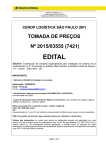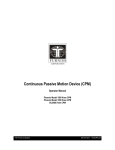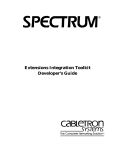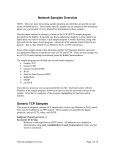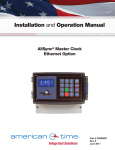Download Tardis 2000 User manual - HC Mingham
Transcript
Tardis 2000 v1.6
Tardis 2000 Time Synchronisation
page 2 of 61
1 Contents
1 CONTENTS
2
2 SHAREWARE
4
3 WELCOME TO TARDIS 2000
5
4 INSTALLATION
6
4.1 TARDIS 2000
4.2 APPLICATION OR SERVICE?
4.3 INSTALL COMMAND LINE OPTIONS
4.4 MANUAL INSTALLATION
4.5 RUNNING TARDIS 2000 SERVICE IN DEBUG MODE
4.6 COEXISTENCE OF TARDIS 2000 SERVICE WITH WINDOWS TIME SERVICE
4.7 LOGGING
4.8 TARDIS 2000 AND WINDOWS FIREWALL
6
6
6
7
8
8
9
9
5 EXAMPLES OF USING TARDIS 2000
12
5.1 A STAND-ALONE PC USING A DIAL-UP CONNECTION TO THE INTERNET
5.2 A PC ON A LAN ACCESSING INTERNET SERVICES
5.3 A PC ON A LAN USING LOCAL TIME SERVERS
5.4 A PC WITH A GPS OR RADIO DEVICE
5.5 TARDIS 2000 ACTING AS A TIME SERVER
12
12
12
12
12
6 CONFIGURING TARDIS
13
6.1 MAIN SCREEN
13
7 OPTIONS PAGES
16
7.1 SETTING THE TIME
7.2 DIALUP
7.3 GENERAL OPTIONS
7.4 INFORMATION PAGE
7.5 GPS
7.6 BROADCAST NTP/NTP
7.7 HTTP PROXY SETTINGS
7.8 ALERTS
16
18
19
20
22
23
25
25
8 TIME SERVERS
27
9 TECHNICAL SUPPORT FOR TARDIS 2000
28
10 REGISTERING AND PAYING FOR TARDIS 2000
29
10.1 PAYMENTS
10.2 UPGRADE POLICY
29
30
11 FREQUENTLY ASKED QUESTIONS
34
12 TIME PROTOCOLS
40
Copyright © H.C. Mingham-Smith Ltd. 1994-2015
Tardis 2000 Time Synchronisation
12.1 NTP BROADCAST PROTOCOL
12.2 NMEA
12.3 HTTP PROTOCOL
12.4 GALLEON RADIO CLOCK
12.5 KALLISTO GPS CARD
12.6 RFC2030 (SNTP)
12.7 RFC867 (DAYTIME)
12.8 RFC868 (TIME)
12.9 RFC792 (ICMP TIMESTAMP SECTION)
12.10 OTHER RADIO AND GPS CLOCKS SUPPORTED.
Copyright © H.C. Mingham-Smith Ltd. 1994-2015
page 3 of 61
40
40
40
41
42
44
56
57
58
60
Tardis 2000 Time Synchronisation
page 4 of 61
2 Shareware
Copyright Notice
1994-2015 H.C. Mingham-Smith Ltd. ("The author")
THE SOFTWARE IS PROVIDED "AS-IS" AND WITHOUT WARRANTY OF ANY KIND, EXPRESS,
IMPLIED OR OTHERWISE, INCLUDING WITHOUT LIMITATION, ANY WARRANTY OF
MERCHANTABILITY OR FITNESS FOR A PARTICULAR PURPOSE. IN NO EVENT SHALL THE
AUTHOR BE LIABLE FOR ANY SPECIAL, INCIDENTAL, INDIRECT OR CONSEQUENTIAL
DAMAGES OF ANY KIND, OR ANY DAMAGES WHATSOEVER RESULTING FROM LOSS OF USE,
DATA OR PROFITS, WHETHER OR NOT ADVISED OF THE POSSIBILITY OF DAMAGE, AND ON
ANY THEORY OF LIABILITY, ARISING OUT OF OR IN CONNECTION WITH THE USE OR
PERFORMANCE OF THIS SOFTWARE.
Tardis 2000 is Shareware. This is a complete working version. There are no annoying reminder screens
about what it costs, and there are no disabled features. If you continue to use it after evaluating it please send
payment as detailed on page 29.
Copyright © H.C. Mingham-Smith Ltd. 1994-2015
Tardis 2000 Time Synchronisation
page 5 of 61
3 Welcome to Tardis 2000
Tardis 2000 is a utility for Windows that makes sure your PC’s clock tells the right time. It can find out what
the right time is in various ways including using networked timeservers, GPS (The Global Positioning
System), Radio clocks, and by listening for time broadcasts over a LAN. Tardis 2000 requires the TCP/IP
networking protocol to be installed.
The service version of Tardis 2000 runs as a Windows “service”, just like other services that come as
standard with Windows.
It acts as both a server and client for the supported protocols. I.e. it can get the time from a timeserver with
the ‘correct’ time and then make the ‘correct’ time available to local clients.
Tardis 2000 running on a central server can be used as a master time source for the domain by running Tardis
or K9 on the other workstations of the domain using the server machine as the timeserver. See
http://www.mingham-smith.com/ for details of K9.
Tardis 2000 can use the following time protocols
RFC868 (Time)
RFC867 (Daytime)
RFC2030 (SNTP)
Broadcast NTP
HTTP protocol.
Kallisto GPS.
NMEA compliant GPS cards.
Galleon Radio Clock
ICMP timestamp
Trimble Palisade
EndRun Technologies Præcis Ct
Kinemetrics Truetime
Spectracom WWVB
NeoClock
Expert mouseCLOCK
Serial Radio Clock connected to DCD pin
EMC Professional in XNTP mode
IRIG-B
Thanks
We would like to thank Mark Symons who helped enormously in the development of Tardis 2000.
Copyright © H.C. Mingham-Smith Ltd. 1994-2015
Tardis 2000 Time Synchronisation
page 6 of 61
4 Installation
4.1
Tardis 2000
Tardis 2000 is distributed as a setup file called tardis2000.exe. This manual and the installable Tardis 2000
files are contained within it. Run the tardis2000.exe program and Tardis 2000 will automatically be
installed.
4.2
Application or Service?
If your PC runs Windows 95/98/ME you will only be given the option to install the Application version of
Tardis. If you use more recent versions of Windows you have the option of using either the application
version or the service version.
We recommend that you use the service version.
Both versions have essentially the same functionality. The difference is that the application is a stand-alone
utility; the service version is a control panel and a background service that runs all the time whether anyone
is logged in or not.
You should log into your Windows NT/2000/XP/2003 system as a user with administrative privileges.
Tardis 2000 must be installed and configured by someone with administrative privileges.
4.3
Install command line options
Tardis 2000 now uses the wonderful Inno Setup (http://www.jrsoftware.org/isinfo.php). As a result the
tardis2000.exe setup program has the following install options provided by Inno setup.
The tardis2000.exe Setup program accepts optional command line parameters. These can be useful to system
administrators, and to other programs calling the Setup program.
/SP/SILENT, /VERYSILENT
/LOG
Disables the This will install... Do you wish to continue? prompt at the
beginning of Setup.
Instructs Setup to be silent or very silent. When Setup is silent the wizard
and the background window are not displayed but the installation progress
window is. When a setup is very silent this installation progress window is
not displayed. Everything else is normal so for example error messages
during installation are displayed and the startup prompt is (if you haven't
disabled it the '/SP-' command line option explained above)
If a restart is necessary and the '/NORESTART' command isn't used (see
below) and Setup is silent, it will display a Reboot now? message box. If
it's very silent it will reboot without asking.
Causes Setup to create a log file in the user's TEMP directory detailing file
installation actions taken during the installation process. This can be a
helpful debugging aid. For example, if you suspect a file isn't being
replaced when you believe it should be (or vice versa), the log file will tell
you if the file was really skipped, and why.
The log file is created with a unique name based on the current date. (It will
not overwrite or append to existing files.) Currently, it is not possible to
customize the filename.
The information contained in the log file is technical in nature and
Copyright © H.C. Mingham-Smith Ltd. 1994-2015
Tardis 2000 Time Synchronisation
/NOCANCEL
/NORESTART
/RESTARTEXITCODE=exit
code
/LOADINF="filename"
/SAVEINF="filename"
/DIR="x:\dirname"
/GROUP="folder name"
/NOICONS
/COMPONENTS="comma
separated list of component
names"
4.4
page 7 of 61
therefore not intended to be understandable by end users. Nor is it designed
to be machine-parseable; the format of the file is subject to change without
notice.
Prevents the user from cancelling during the installation process, by
disabling the Cancel button and ignoring clicks on the close button. Useful
along with '/SILENT' or '/VERYSILENT'.
Instructs Setup not to reboot even if it's necessary.
Specifies the custom exit code that Setup is to return when a restart is
needed. Useful along with '/NORESTART'. Also see Setup Exit Codes.
Instructs Setup to load the settings from the specified file after having
checked the command line. This file can be prepared using the
'/SAVEINF=' command as explained below.
Don't forget to use quotes if the filename contains spaces.
Instructs Setup to save installation settings to the specified file. Don't
forget to use quotes if the filename contains spaces.
Overrides the default directory name displayed on the Select Destination
Location wizard page. A fully qualified pathname must be specified.
Overrides the default folder name displayed on the Select Start Menu
Folder wizard page.
Instructs Setup to initially check the Don't create any icons check box on
the Select Start Menu Folder wizard page.
Overrides the default components settings. Using this command line
parameter causes Setup to automatically select a custom type.
Manual Installation
Occasionally the installation of the Tardis 2000 Service must be done manually, usually where other software
interferes with the automatic installation process. The Tardis 2000 Service files can be requested by E-mail
and installed manually as follows.
Log into your Windows NT/2000/XP/2003 system as a user with administrative privileges.
Decide which directory you are going to put the tardisNT.exe in, and move it there. A good choice is the
\WINNT\SYSTEM32 directory, which is where many other services live. Using the Security/Permissions
menu option in the File Manager, ensure that the SYSTEM user has read permission for the file.
Install tardisNT.exe as a service by running the program from the Windows NT/2000/XP/2003 command
line, specifying the add flag. (NOTE - it is vital that you execute this command specifying the copy of
tardisNT.EXE which you placed in the \WINNT\SYSTEM32 directory, and not using some other copy
which you plan subsequently to delete.) For instance:
tardisNT add
The program will register itself and its location with the Service Manager, and will report success or failure.
In the case of failure, see the section on Installation Problems below.
To verify that the installation has succeeded, start the Windows NT/2000/XP/2003 Control Panel and
double-click on the Services icon. The resulting dialog should list Tardis as one of the installed services.
4.4.1 Installation Problems
Message
Meaning
The system says that tardisNT.EXE is not a
Windows NT/2000/XP/2003 program
This is probably because you are trying to run an
executable for the wrong sort of processor or the file
Copyright © H.C. Mingham-Smith Ltd. 1994-2015
Tardis 2000 Time Synchronisation
page 8 of 61
is damaged.
This function is only valid in Win32 mode. (0x78)
You aren’t running Windows NT/2000/XP/2003!
“Failed to create service.”
This error message occurs if you try to install
tardisNT when it is already installed.
Could not start tardisNT time synchronization
service on \\yourmachine.Error 0002: The system
cannot find the file specified.
The Service Manager could not locate
tardisNT.EXE. This probably means it has been
moved, or has not been installed correctly. Remove
and reinstall tardisNT - see section above for details.
Could not start tardisNT time synchronization
service on \\yourmachine.Error 0005: Access is
denied.
tardisNT.EXE is inaccessible to the SYSTEM user.
By default, the Service Manager starts the tardisNT
process running under a user ID of SYSTEM. The
executable file for the service must be readable by
this user.
4.4.2 Manual Deinstallation
This section describes what to do if you want to remove the Tardis 2000 Service from your computer.
At the Windows NT/2000/XP/2003 command line, run tardisNT with the cleanup option:
tardisNT cleanup
This will remove the service and the control panel after a reboot.
4.5
Running Tardis 2000 Service in debug mode
To make debugging easier you can run Tardis in debug mode like so.
TARDISNT debug
This should run Tardis as a console application. Log information and debugging are shown on the screen.
Make sure that the service isn’t running when you run tardisnt in debug mode otherwise you will be running
it twice.
4.6
Coexistence of Tardis 2000 service with Windows Time Service
Windows 2000, XP and more recent versions have a primitive Time Service installed by default.
The Tardis 2000 Service and the Windows Time Service require some help to coexist on the same PC
because they both try to use the same NTP network port.
Tardis 2000 allocates the port and the Windows Time Service complains and is generally unhappy.
When the control panel is started Tardis 2000 will warn you when the Windows Time Service is active.
Copyright © H.C. Mingham-Smith Ltd. 1994-2015
Tardis 2000 Time Synchronisation
page 9 of 61
You have the option to stop the Windows Time Service removing the problem. If this option is selected the
Windows Time Service will be stopped and disabled. Note: This may not be possible if other services
depend on the Windows Time Service, as may be the case on primary domain controllers.
The best workaround is to make the Tardis 2000 service depend on the Windows Time Service so it starts
second. Tardis 2000 will work around port 123 being unavailable and everything should be ok. Tardis 2000
may not be able to act as an NTP server if this option is selected.
On Windows firewall blocks NTP requests from reaching Tardis 2000. Select the option to allow NTP or
open the port manually as shown here.
4.7
Logging
If an error in the operation of the service occurs, the error will be logged in the Application Event Log. This
log may be viewed with the Event Viewer, which you will find in the Administrative Tools program group.
See your Windows NT/2000/XP/2003 documentation for details of how to use the Event Viewer.
The events logged in the Application Event Log can be associated with a Tardis problem (e.g. a file I/O
error, or a system call failure caused by lack of resources, or a problem with the configuration information).
Problems associated with the network are recorded in the Application Event Log as Warning events.
Tardis also logs information such as Time updates and service starts and stops.
Further information on events that may be logged by Tardis is given in the chapter on troubleshooting on
page 20 of this manual.
Note that the Event Viewer uses the TARDIS.CPL file to interpret messages associated with events.
Therefore, if you delete the TARDIS.CPL file, Tardis events in your Application Event Log will be
unintelligible.
4.8
Tardis 2000 and Windows firewall
Windows a firewall feature that may interfere with the normal operation of Time synchronization products.
This describes how to configure the firewall to allow unsolicited NTP messages through to K9 and Tardis.
Open the firewall control panel. Make sure the settings are set like this
Copyright © H.C. Mingham-Smith Ltd. 1994-2015
Tardis 2000 Time Synchronisation
On the Exception tab click on 'Add Port'
Copyright © H.C. Mingham-Smith Ltd. 1994-2015
page 10 of 61
Tardis 2000 Time Synchronisation
Then add a setting to allow NTP.
Press OK and everything should work.
Copyright © H.C. Mingham-Smith Ltd. 1994-2015
page 11 of 61
Tardis 2000 Time Synchronisation
page 12 of 61
5 Examples of using Tardis 2000
5.1
A Stand-alone PC Using a Dial-Up Connection to the Internet
Many users configure Tardis to reset their PC’s clock each time they log on to the Internet using a dial-up
connection. Tardis should be running before the dial-up connection is established and configured to access a
time server once you are logged on to the Internet. Simply select “Options”, click on the dial-up tab, then
click on “Watch for dial-up”. When Tardis 2000 detects an active RAS connection it uses it to access a time
server and sets the time, otherwise it will sit there waiting. If the option is not set Tardis may cause a dialup
connection to be started depending on your dialup networking settings. Tardis knows nothing about this and
will assume that you are on a LAN, Tardis will not shutdown any connection automatically started in this
way.
Tardis 2000 incorporates a default set of Time Servers. It will always access the one at the top of the list, so
if you wish to obtain the time from a particular server move it to the top of the list (by right clicking on it and
selecting “move to top”).
5.2
A PC on a LAN Accessing Internet Services
For LANs connected directly to the Internet, any PC on the LAN can run Tardis 2000 as outlined above.
Alternatively a single PC can run Tardis 2000 to obtain the time and then broadcast it to the other PCs on the
LAN with the clients running Tardis 2000’s companion program K9.
However, many LANs are connected to the Internet via firewalls which block the protocols used by Tardis
2000 and other time synchronisation programs. Firewalls are usually open to some protocols, typically the
HTTP protocol, and Tardis 2000 is unique in its ability to use the HTTP protocol to obtain the time.
To use the HTTP protocol, select HTTP in the Server details dialog.
(It should be noted that other protocols might work if the firewall allows access to the relevant ports)
The situation for a proxy server is similar to a firewall. Proxy servers block all protocols except HTTP and
are typically used on company Intranets.
To use a proxy server the settings must be set up in the proxy server options tab.
5.3
A PC on a LAN Using Local Time Servers
Tardis 2000 can use existing time servers on a company LAN to ensure that PC clocks are synchronised
locally. Typical time servers are UNIX machines, routers, dedicated time server devices, and other copies of
Tardis.
5.4
A PC with a GPS or Radio Device
Tardis 2000 can obtain the time from GPS and Radio devices so no Internet connection or other time server
is required. If one PC on a LAN is equipped with a GPS or Radio device, Tardis 2000 can, of course,
broadcast the time obtained from this to clients on the LAN (the clients running K9 as outlined above).
5.5
Tardis 2000 Acting as a Time Server
By default, Tardis 2000 is always a server as well as a client so other PCs on a LAN can use it as a time
source. This would ensure that the clocks of all PCs on a LAN were synchronised to the same time.
Copyright © H.C. Mingham-Smith Ltd. 1994-2015
Tardis 2000 Time Synchronisation
page 13 of 61
6 Configuring Tardis
Tardis and the NT/2000/XP/2003 service version of Tardis are slightly different in the way they are
configured. The NT/2000/XP/2003 version has a control panel (Start->Settings->Control panel in NT/2000,
control panel->date time in XP), the standalone version is an application in its own right. Although they are
started differently the user interfaces are basically the same.
6.1
Main Screen
Contents of the main Tardis screen are described below.
Status
(Not present in service
version).
The status messages show what Tardis is up to. The text will change to
provide useful progress and error messages. These messages can be
recorded. See the section on Information.
Add
Add allows new time servers to be configured. The Server details
dialog allows the details of the server to be entered. Double clicking a
blank space in the server list will also add a server.
Clear all
is a quick way to remove all the servers. You will be asked to confirm
that you want them all deleted.
Import and Export
allow you to load and save lists of servers. This is useful for quickly
configuring Tardis with pre-set lists of servers.
Default
Restore the default list of timeservers
Clicking a server with the right hand mouse button gives the following options.
Open
has the same effect as double clicking the server. An
attempt will be made to connect to it.
Move to Top
moves this server to the top of the list.
Move up
moves this server up one.
Move Down
moves this server down one.
Move to Bottom
moves this server to bottom of list.
Delete
Deletes this server. This can also be done by selecting a
server and pressing the delete key.
Properties
Copyright © H.C. Mingham-Smith Ltd. 1994-2015
will start Server details dialog to allow the server’s details
to be modified.
Tardis 2000 Time Synchronisation
page 14 of 61
Time Services
When the a time server is used the relevant indicator will flash. This is not present on
the service version.
Start/Stop Service
This is only present on the service version. It allows the service to be easily stopped
and started.
Options
This button allows you to configure Tardis’s many features. (Not present on service
version)
6.1.1
Server details
This dialog is used to add new servers and to edit existing time servers.
Protocol
Select the protocol used by your timeserver here.
SNTP is best if you have access to servers that support it. It is the standard way to
synchronize computer clocks.
RFC 868 Time protocols. These allow corrections to the nearest second. Time/udp
uses very little network bandwidth.
HTTP protocol may be required if you are using a firewall/proxy and have no
timeservers on your LAN.
Copyright © H.C. Mingham-Smith Ltd. 1994-2015
Tardis 2000 Time Synchronisation
page 15 of 61
NTP broadcast protocol is a good choice if you have an NTP server on your LAN. It
can be configured to broadcast time information. Tardis will listen for these
broadcasts if you use this protocol.
Kallisto GPS option can be used to get the time from a Kallisto GPS card.
NMEA GPS supports NMEA compliant GPS devices.
The Galleon Radio Clock option can be used to get the time from a Galleon Radio
Clock.
RFC867 protocols are a primitive way to get time information. This should only be
used when there is no other alternative. Since the daytime protocol does not specify
the format of the data returned Tardis must make some compromises. This protocol
will only correct the time by up to ± 30 minutes.
ICMP Timestamp can correct the time to < 1 second and has the advantage that it is
‘serverless’. This protocol is so low level that it asks the server machine’s TCP/IP
driver software for the time rather than requiring a time server program to be running.
Not all IP devices support this feature and those that do don’t always do a good job of
it. Linux does it properly. Later versions of windows are ok.
Trimble Palisade
EndRun Technologies Præcis Ct
Kinemetrics Truetime
Spectracom WWVB
Neol NeoClock
Expert mouseCLOCK
Serial Radio Clock connected to DCD pin
EMC Professional in XNTP mode
IRIG-B
These are all serial port connected radio or GPS clocks.
Address
This setting is the address of the machine that knows the correct time. It may be
entered as a name, e.g. tycho.usno.navy.mil, or as an Internet address e.g.
123.123.123.123.
If you are using a clock connected to a serial port set the address to the COM port the
clock is connected to e.g. COM2
When using the NTP broadcast protocol the address may be left blank in which case
Tardis will listen to any broadcasts. If an address is entered then Tardis will only
listen to broadcasts from that machine.
Name
You may enter a descriptive name for the server here. If none is entered the address
of the server is used instead.
Reject unsynchronized
NTP
If this is set Tardis will reject time information from NTP servers that claim to be
unsynchronised. This can happen if the server has lost touch with its time source.
Use proxy server
When you use the HTTP protocol you can select this to use a proxy server. This is
often required where Tardis is being used within a company Intranet.
Copyright © H.C. Mingham-Smith Ltd. 1994-2015
Tardis 2000 Time Synchronisation
page 16 of 61
7 Options Pages
The options pages allow you to configure Tardis.
Setting the time
These options control when and if the time is set.
Dialup
This controls how dialup connections are handled. If you don’t have RAS
installed this page will be absent.
General
This page contains miscellaneous options.
Information
Statistics and logging options are set using this page.
GPS
If you have access to a GPS device it can be configured on this page.
Broadcast NTP/NTP
Configure NTP and NTP broadcasts for use with Tardis or K9.
HTTP Proxy settings
Set the HTTP proxy settings for use with HTTP connections.
Alerts
Configure Alerts to inform administrators of loss of synchronization.
.
7.1
Setting the time
These options control when and if the time is set.
Set the time
If this is set Tardis will set the system time, Switch it off if you don’t initially trust
the server you are connecting to. It gives you a chance to see what kind of time it is
going to give you first without setting your PC’s time to 10:61 77 Jan. 1914
accidentally.
Set Timezone
This button takes you to the Control Panel for Date and Time so you can set up your
timezone and whether you use daylight saving time or not.
Minimum
Tardis checks that time correction is worth bothering about. The Minimum
Copyright © H.C. Mingham-Smith Ltd. 1994-2015
Tardis 2000 Time Synchronisation
correction
allowed/Adjust
clock frequency
if below
page 17 of 61
correction allowed setting specifies what is reasonable. This is useful if you want to
avoid frequent trivial changes to the time that might upset other applications. It is
also possible to specify that any correction is allowed by sliding the control all the
way to the left.
On the service version this option’s meaning changes if the ‘Adjust clock frequency’
is set. When this is set ALL time corrections are used even small ones. They are
used to adjust the frequency of the PC’s clock to make it drift less.
When this is used the value of this setting determines when the clock is stepped
rather than the frequency adjusted.
Maximum
correction
allowed
Tardis validates the time received from the server by checking that the amount of
correction is not so far out that it must be wrong. The Allowable correction settings
specify what is reasonable. This is useful if your timezone is wrong or your
timeserver has gone mad.
It is also possible to specify that any correction is allowed by sliding the control all
the way to the left.
Allow
correction of
maximum size if
larger
This option allows corrections up to but not larger than the maximum. If this is set
and the maximum correction allowed is 1 second a correction of 10 seconds would
result in a correction of 1 second. If the option weren’t set the correction of 10
seconds would be rejected.
How often the
time is set
This tells Tardis to get and set the time every so often. It depends on how bad your
clock is. I use once every 60 minutes to keep mine in synch. Once a day may be
enough for you.
You can also tell Tardis to exit once it has corrected the time by sliding the control
all the way to the left (Not on the service version). This is useful for setting the time
when first starting the PC.
Note: Once this has been set you may not be able to change the setting because
Tardis will set the time and terminate before you get the chance. If this happens then
hold done the SHIFT key and start Tardis. This will prevent it terminating.
Adjust
automatically
If this is set Tardis will gradually adjust how often it checks the time. This option
works in conjunction with the Minimum allowed and Maximum allowed settings. If
a correction is less than the minimum the time is increased. If a correction is made
the time is decreased. The minimum correction setting effectively becomes the
definition of the required accuracy.
Adjust clock
frequency
This option is only present on the service version. When set Tardis will adjust the
frequency of the PC’s clock to keep it in synch rather than stepping the clock.
Copyright © H.C. Mingham-Smith Ltd. 1994-2015
Tardis 2000 Time Synchronisation
7.2
page 18 of 61
Dialup
Set this option to make Tardis watch for an active RAS dialup connection before doing anything. When the
connection is established Tardis will check the time. If you don’t have RAS installed this page will be
absent. If you are using a dial on demand router rather than RAS this option won’t work.
Note: Tardis won’t initiate a connection for you and close it down automatically.
Copyright © H.C. Mingham-Smith Ltd. 1994-2015
Tardis 2000 Time Synchronisation
7.3
page 19 of 61
General options
Start minimized
If this is set then Tardis will start in a minimized state. (Not service version)
Hide if minimized
If this is set Tardis will hide itself if it is minimized. You can show it and hide it again
by clicking on the Tardis Icon in the system tray. (Not service version)
Notify other
applications when
the time is set
Tardis can tell all the other running applications that the time has been changed. This
may upset a small number of applications, e.g. Microsoft schedule, so it is off by
default.
Automatically
change server on
failure
If this is set Tardis will automatically change to a different server if it cannot contact
the one currently selected. It will cycle through all the servers in the list.
Automatically
change server on
success
If this is set Tardis will automatically change to a different server if it successfully
contacts the one currently selected. It will cycle through all the servers in the list.
This may be useful as a way of checking which servers are active.
Note: This option shouldn’t be used in normal operation. It will cause the time to be
checked every 2 seconds.
Always start at
the top of the
server list
If this is set Tardis will try to use the server at the top of the list first before moving on
down the list until a good server is found. This differs from the normal behaviour
where Tardis stays with the good server and never retries the servers that previously
failed.
Visit the Tardis
Website
If you press this button your web browser should start and you should be connected to
the Tardis home page. If your web browser isn’t set up quite right it won’t work.
Generate debug
info
If you have problems with Tardis press this button and include the output with any email messages.
Copyright © H.C. Mingham-Smith Ltd. 1994-2015
Tardis 2000 Time Synchronisation
7.4
page 20 of 61
Information page
This page contains information on the last time correction and also controls what information is logged and
where. The information is automatically updated as Tardis runs.
7.4.1 Statistics
Estimate of clock
drift
This is an estimate of how much your PC’s clock would drift without Tardis. It
may require a long time (hours) before this value will settle down to a reasonable
value. It is only going to settle down if you are using SNTP, Radio or GPS. The
other protocols aren’t accurate enough.
Last time corrected
When the time was last corrected.
Last correction
The size of the last correction.
Time source
Where the correction came from.
7.4.2 Logging
These options control what is logged. Messages may be placed in a file, sent to a Unix/Linux syslog server
or saved to the system event log Service version only). Tardis can use one or more of these destinations at
the same time.
Log to file
If logging to a file press the … button to set the location of the log file.
The file name may contain strftime escape sequences to allow the logging file to be named appropriately.
E.g. %B will be replaced by the full month name so the log file %B.txt will be called April.txt in april and
May.txt in may. This is the full list
%a
Abbreviated weekday name
%A
Full weekday name
%b
Abbreviated month name
Copyright © H.C. Mingham-Smith Ltd. 1994-2015
Tardis 2000 Time Synchronisation
%B
Full month name
%c
Date and time representation appropriate for locale
%d
Day of month as decimal number (01 – 31)
%H
Hour in 24-hour format (00 – 23)
%I
Hour in 12-hour format (01 – 12)
%j
Day of year as decimal number (001 – 366)
%m
Month as decimal number (01 – 12)
%M
Minute as decimal number (00 – 59)
%p
Current locale’s A.M./P.M. indicator for 12-hour clock
%S
Second as decimal number (00 – 59)
%U
Week of year as decimal number, with Sunday as first day of week (00 – 53)
%w
Weekday as decimal number (0 – 6; Sunday is 0)
%W
Week of year as decimal number, with Monday as first day of week (00 – 53)
%x
Date representation for current locale
%X
Time representation for current locale
%y
Year without century, as decimal number (00 – 99)
%Y
Year with century, as decimal number
%z, %Z
Time-zone name or abbreviation; no characters if time zone is unknown
%%
Percent sign
page 21 of 61
Log to a syslog server
Unix and Linux systems provide a networked equivalent to the Windows system event log. Tardis can send
messages to one of these servers.
If syslog is selected you should enter the address of the syslog server. Note: the syslogd must be started with
the –r option to enable it to receive remote messages from Tardis.
Log to eventlog
The Tardis 2000 service logs to the system eventlog. This may be viewed using the Windows
NT/2000/XP/2003 event log viewer. Tardis log messages are under the ‘Application’ section.
Log information
messages
A minimal amount of logging will be recorded.
Log warning
messages
Warning messages will be logged.
Log error messages
Errors will be logged
Log debug messages
Debug messages are logged. If you have a problem with Tardis please switch this
on and include the output in any e-mail that you may send me. It might help us
find the problem.
Copyright © H.C. Mingham-Smith Ltd. 1994-2015
Tardis 2000 Time Synchronisation
7.5
page 22 of 61
GPS
This page configures the GPS connection.
Speed
Select the baudrate it uses.
NMEA Wakeup
If your GPS device requires a string to enable NMEA messages the NMEA wakeup
string can be entered. The NMEA protocol is generally supported by most GPS systems.
E.g. for the Delorme Tripmate the wakeup string is ASTRAL\r
Copyright © H.C. Mingham-Smith Ltd. 1994-2015
Tardis 2000 Time Synchronisation
7.6
page 23 of 61
Broadcast NTP/NTP
Tardis can broadcast NTP time information using broadcasts and multicasts. Use it if there are no NTP time
broadcasts on your LAN. When the time is broadcast the broadcast NTP timeserver indicator will flash
green (Not on service version). Tardis’ companion program K9 is a minimal client for this protocol. See
http://www.mingham-smith.com/for details of K9.
Broadcast addresses
By default Tardis will broadcast to the local subnet broadcast address
255.255.255.255. Other addresses may be added and deleted to enable Tardis to
broadcast to other subnets or even single PCs.
Broadcast frequency
Use this setting to alter how often Tardis broadcasts the time.
Enable NTP
broadcasts
Select this to make Tardis broadcast NTP time information.
Only serve if
synchronized
Select this if you want Tardis to only broadcast and/or respond to NTP requests
once it has synchronized the time. If a time synchronization alert happens the
state will return to unsynchronized.
NTP Stratum
This allows the NTP stratum to be set for all the NTP messages that Tardis sends.
This affects the client and the server side of Tardis’s NTP protocols. If using
Tardis as a server for other clients it may be best to set the stratum to 1. This
option is really for people who are familiar with NTP. Most people won’t need
to touch it.
Add
This will enable you to add an IP address to which you want to broadcast NTP.
Copyright © H.C. Mingham-Smith Ltd. 1994-2015
Tardis 2000 Time Synchronisation
page 24 of 61
Add multicast
Adds the default multicast address to the broadcast list.
Multicast ttl
This sets the ‘time to live’ on the multicasts. It affects how far the multicasts
travel from one subnet to another.
Delete
Select this to delete the selected broadcast address.
Default
Select this to set the broadcast address to the default.
7.6.1 Troubleshooting Broadcast NTP
One way to prove that things are mostly ok is to add the IP address of the target K9/Tardis machine into the
list of broadcast addresses. That should prove that they can talk. The next thing to check is the broadcast
address of the subnet. This can depend on the network.
If your subnet mask is 255.255.255.0 you can try 255.255.255.255 and 255.255.255.0 as the broadcast
address (255.255.255.255 is the default)
You should also try the specific subnet broadcast addresses. If your subnet is 192.168.0.x try 192.168.0.255
and 192.168.0.0.
If your subnet mask differs from 255.255.255.0 on either or both machines let us know and I may be able to
suggest other broadcast addresses to try.
Broadcasts are usually limited to local subnet. Multicasts are able to traverse multiple subnets if your
network is set up to support it.
Copyright © H.C. Mingham-Smith Ltd. 1994-2015
Tardis 2000 Time Synchronisation
7.7
page 25 of 61
HTTP Proxy settings
Tardis may need to know the settings of your proxy server to work with the http protocol. The settings can
probably be found in your web browser options. Tardis attempts to fill these in for you if a browser is
configured.
Address of HTTP proxy
firewall
This is the name or IP address of your proxy/firewall server. You don’t
need to include a http:// prefix.
Port
This is the port number that your proxy/firewall uses.
User name and password
needed
If your proxy/firewall requires authentication select this and enter your
username and password.
7.8
Alerts
It is useful to know if Tardis has lost synchronization. This screen enables you to specify how long before an
alert is raised.
Copyright © H.C. Mingham-Smith Ltd. 1994-2015
Tardis 2000 Time Synchronisation
page 26 of 61
Enable Alerts
Alerts are normally off by default. Check this box to switch them on.
Set the time before an alert is raised. Note: make sure this is longer than the time between time checks
otherwise it will always send an alert before the next time check.
When an alert happens the clock is marked as unsynchronized and NTP requests may not be served if the
‘only server when synchronized’ option is set.
Alert method
Alerts may be sent as E-mail or a simple dialog box (Not service version). If neither is set Tardis will still
react to the problem by changing server if it is configured to automatically switch servers on failure.
E-mail details
SMTP Server
The server to send e-mail through
To address
The e-mail address of the recipient
Message text
The text of the message
Copyright © H.C. Mingham-Smith Ltd. 1994-2015
Tardis 2000 Time Synchronisation
page 27 of 61
8 Time Servers
Tardis provides servers for all the TCP/IP time protocols that it supports. I.e. you can run Tardis on your PC
and other PC’s will be able to retrieve the time from you. This enables you to lock PC’s clocks together so
that they always agree.
These are the things you need to do to use Tardis as a timeserver
Make sure that all the PCs are running TCP/IP.
If not then install TCP/IP from the settings->control panel->network->add->protocol dialog. Specify a
subnet mask of '255.255.255.0' for the TCP/IP over the Ethernet adapters. This is for a class C address
without subnetting. Then specify IP addresses beginning with 192.168.0.1 for your client computers.
Choose one machine as the server (i.e. the one that knows the correct time). Then specify the IP address of
your Tardis server for the client machines under timeserver (as outlined in the documentation).
When a time service is accessed from another machine the appropriate indicator on the main Tardis screen
will flash to indicate activity. (Not on the service version).
Note: Tardis always acts as a server for all the TCP/IP based protocols that it supports, no additional
configuration is required.
Copyright © H.C. Mingham-Smith Ltd. 1994-2015
Tardis 2000 Time Synchronisation
9 Technical Support for Tardis 2000
Support is available by Internet E-mail the address is [email protected]
The Tardis web site is www.mingham-smith.com
Copyright © H.C. Mingham-Smith Ltd. 1994-2015
page 28 of 61
Tardis 2000 Time Synchronisation
page 29 of 61
10 Registering and Paying for Tardis 2000
The following page details the volume-based charges for Tardis 2000 and incorporates a registration form.
10.1 Payments
There are three ways to pay for registration:
1) By cheque payable to H.C. Mingham-Smith. Please post to the following address:
H. C. Mingham-Smith
33 Arthur Rd.
Wokingham,
Berkshire RG41 2SS
England.
2) By Bank Transfer
If you would prefer to pay by this method, please contact us on the following e-mail address to request bank
account details.
E-mail address: [email protected]
3) By Credit Card Online
We have an arrangement with mycommerce.com who provide on-line credit card registration.
To register online, click on the relevant link
Tardis 2000
Tardis 2000 NT Service
Tardis 2000 Corporate License
K9
Please note that REGNOW cannot handle source code registrations.
Invoices
If your company requires an invoice before sending payment, please e-mail us at [email protected] or post your purchase order to the above address.
Charges for registering your use of Tardis 2000 are based on the number of computers on which it is
installed and are detailed on the registration forms which customers are requested to complete. Prices are
quoted in US dollars, EUROs and £ Sterling. Customers outside the US or European Union are requested to
convert the US dollar prices to the equivalent amount in their local currency.
Please note that receipts are normally sent via e-mail. If you require a receipt to be sent by post or a license
to be issued, please request this when registering.
4) Our Company Details
HC Mingham-Smith Limited Registered in England No: 3676999.
Registered Office: TSB House, 39A Peach Street, Wokingham, Berks RG40 1XJ
VAT Registration Number: 642 4733 43
Copyright © H.C. Mingham-Smith Ltd. 1994-2015
Tardis 2000 Time Synchronisation
page 30 of 61
10.2 Upgrade Policy
Customers who register their use of our software and pay the appropriate registration fee are entitled to a free
upgrade to the next version of the software but are requested to pay an upgrade fee for the subsequent
version.
The upgrade fee is 50% of the standard price.
Example
Company X purchased 50 Tardis 2000 (v1.3) registrations in August 2001. They were entitled to a free
upgrade to v1.4 but now wish to upgrade to v1.5.
The upgrade fee is
50% of 50 x US$4.00 = US$100
If, however, the company also wished to run the software on additional PCs they would be required to pay
the standard fee for those registrations.
Copyright © H.C. Mingham-Smith Ltd. 1994-2015
Tardis 2000 Time Synchronisation
page 31 of 61
Tardis 2000 Registration Form
(For customers outside the European Union)
UK VAT (Value Added Tax) does not apply to customers outside the European Union. The following prices
are given in US$. Non-US customers are invited to convert the following prices to their local currency.
Quantity
Please indicate the number of computers on which Tardis 2000 is installed and calculate the correct price
1 computer
Computer at $20 each =
2 to 9 computers:
computers at $12 each =
10 to 24 computers:
computers at $8 each =
25 to 49 computers:
computers at $6 each =
50 to 99 computers:
computers at $4 each =
100 to 199 computers:
computers at $3 each =
200+ computers:
computers at $2.50 each =
Corporate License
Any number of copies for your whole company/organisation $2000
Source license
The source of Tardis 2000 is available for $200; please note that you are still required to pay the appropriate
registration fee to run Tardis 2000 or software derived from the source.
Please provide the following information when registering:
Full Name/Name of company:
Your Address:
E-Mail Address:
Windows Version:
Tardis 2000 version
Where did you obtain Tardis 2000?
Please send e-mail regarding Tardis 2000 to [email protected]
Visit the Tardis Home Page http://www.mingham-smith.com/
Copyright © H.C. Mingham-Smith Ltd. 1994-2015
Tardis 2000 Time Synchronisation
page 32 of 61
Tardis 2000 Registration Form
(For customers in the European Union, but not in the UK)
Customers in the European Union who use the software for business purposes are responsible for paying
VAT at the appropriate rate in their home country. Customers registering their own personal use should pay
VAT at the UK rate of 20% to HC Mingham-Smith Limited. The following prices are in EUROs and are
exclusive of VAT. Prices may be converted to the customer’s "home" currency if preferred.
Quantity
Please indicate the number of computers on which Tardis 2000 is installed and calculate the correct price
1 computer
Computer at 23€ plus VAT each =
2 to 9 computers:
Computers at 14€ plus VAT each =
10 to 24 computers:
Computers at 9.50€ plus VAT each =
25 to 49 computers:
Computers at 7€ plus VAT each =
50 to 99 computers:
Computers at 5€ plus VAT each =
100 to 199 computers:
Computers at 3.50€ plus VAT each =
200+ computers:
Computers at 3€ plus VAT each =
Corporate License
Any number of copies for your whole company/organisation 2300€ plus VAT
Source license
The source of Tardis 2000 is available for 230€ plus VAT; please note that you are still required to pay the
appropriate registration fee to run Tardis 2000 or software derived from the source.
Please provide the following information when registering:
Full Name/Name of company:
Your Address:
E-Mail Address:
Windows Version:
Tardis 2000 version
Where did you obtain Tardis 2000?
Please send e-mail regarding Tardis 2000 to [email protected]
Visit the Tardis Home Page http://www.mingham-smith.com/
Copyright © H.C. Mingham-Smith Ltd. 1994-2015
Tardis 2000 Time Synchronisation
page 33 of 61
Tardis 2000 Registration Form
(For UK customers)
UK VAT (Value Added Tax) at 17.5% applies to sales to UK customers. The following prices are exclusive
of VAT please add 17.5% to the final total.
Quantity
Please indicate the number of computers on which Tardis 2000 is installed and calculate the correct price
1 computer
Computer at £12.50 plus VAT each =
2 to 9 computers:
Computers at £7.50 plus VAT each =
10 to 24 computers:
Computers at £5.00 plus VAT each =
25 to 49 computers:
Computers at £3.75 plus VAT each =
50 to 99 computers:
Computers at £2.50 plus VAT each =
100 to 199 computers:
Computers at £1.88 plus VAT each =
200+ computers:
Computers at £1.56 plus VAT each =
Corporate License
Any number of copies for your whole company/organisation £1250 plus VAT
Source license
The source of Tardis 2000 is available for £125 plus VAT; please note that you are still required to pay the
appropriate registration fee to run Tardis 2000 or software derived from the source.
Please provide the following information when registering:
Full Name/Name of company:
Your Address:
E-Mail Address:
Windows Version:
Tardis 2000 version
Where did you obtain Tardis 2000?
Please send e-mail regarding Tardis 2000 to [email protected]
Visit the Tardis Home Page http://www.mingham-smith.com/
Copyright © H.C. Mingham-Smith Ltd. 1994-2015
Tardis 2000 Time Synchronisation
page 34 of 61
11 Frequently asked questions
Q
A
Tardis goes through the whole list of time servers without stopping
Make sure that you don't have the 'automatically change server on success' option set. This option is
used the quickly scan through the server list. It shouldn't be used for normal operation.
Q
A
I can’t tell what the Tardis 2000 service is doing
Try running tardisnt from the command line so you can see what is going on in real time.
First , stop the service.
Then start a command prompt. Type
tardisnt debug
This will start the service in debug mode. It can be stopped with control-c.
Q
A
I want to disable Tardis’s time services
You can disable some of the Tardis time services but not the NTP service. It is too closely linked to
the client side. From the start menu select 'run'. Type 'regedit' in the box and hit return.
You should see a thing rather like the explorer start.
Follow the folders down like you would in explorer to get to the
HKEY_CURRENT_USER\Software\Tardis\
folder
you should see a list of keys on the right side now.
Add keys as follows they are all of type DWORD.
UDPServer
TCPServer
867UDPServer
867TCPServer
0
0
0
0
Now shut down the regedit program and run tardis. All should be well.
This is for Tardis 2000 for 95/98/ME. The same applies to Tardis 2000 NT Service but the keys are
in HKEY_LOCAL_MACHINE\SYSTEM\CurrentControlSet\Services\Tardis\Parameters\
Q
A
Tardis 2000 may give error 87 messages after being able to sync one time.
This can be fixed as follows.
Win95 comes with Winsock 1, Tardis2000 requires Winsock 2, which can be downloaded free from
Microsoft's Web site.
To get Winsock 2, go to Microsoft's Windows Update web page (a menu item in IE 5.5's "tools"
menu) and do a search for Winsock 2.
Microsoft recommends that you also install a Y2K fix after installing either Winsock 2 or DUN 1.3.
The link for that is right there on the Winsock 2 page, as are the instructions for downloading &
installing.
Copyright © H.C. Mingham-Smith Ltd. 1994-2015
Tardis 2000 Time Synchronisation
Q
A
page 35 of 61
Tardis starts then immediately disappears
The 'How often the time is set' setting can be set to tell Tardis to exit once it has corrected the time by
sliding the control all the way to the left.
Once this has been set you may not be able to change the setting because Tardis will set the time and
terminate before you get the chance. If this happens then hold done the SHIFT key then start Tardis.
This will prevent it terminating.
Q
A
What is the format of the import/export file
The import/export file format is pretty simple.
One line per server.
The fields are separated by | characters.
field 1 is the name
field 2 is the address
field 3 is the protocol (0-9)
field 4 is whether a proxy server is used (for HTTP)
field 5 is whether unsynchronized NTP should be rejected (SNTP)
e.g.
ntp.demon.co.uk|ntp.demon.co.uk|0|0|1
Q
A
Tardis can’t get the time from internet time servers
Firewalls or proxy servers will block most of the time protocols that Tardis uses.
The one that might work is the HTTP protocol.
Another possibility is to open your firewall/proxy tcp port 37 and use the RFC868/tcp protocol.
Q
A
Tardis doesn’t send from port udp/123, which means my firewall doesn’t allow the responses
through/generates bogus virus warnings.
By default Tardis SENDs to port 123 but the SOURCE port it uses is allocated by the system so the
responses come in on a different port number. There is a tweak in the registry you can make to force
Tardis to lock the source port to 123.
the key to add is
HKEY_LOCAL_MACHINE\SYSTEM\CurrentControlSet\Services\Tardis\Parameters\SNTPFix
it is a DWORD and should be set to 1
The same applies to Tardis 2000 but the key is
HKEY_CURRENT_USER\Software\Tardis\SNTPFix
Q
A
I want Tardis to set the time at an exact time of day.
The best way to do this it to use the non-service version of Tardis and run it so that it terminates after
getting the time. You then run Tardis at the time you want using the NT AT command or win 95/98's
task scheduler.
Q
A
Tardis doesn’t synchronize with my GPS/Radio clock.
Tardis may not synchronize with a GPS source for various reasons.
Tardis may not see the NMEA messages because the wrong serial port is being used or the baud rate
is incorrect.
If it is seeing messages but isn't synchronizing it is probably because the GPS device hasn't had
Copyright © H.C. Mingham-Smith Ltd. 1994-2015
Tardis 2000 Time Synchronisation
page 36 of 61
sufficient time to see enough satellites to synchronize.
Before Tardis 2000 V1.3 the GPS device was required to send a message every second. Some GPS
devices don't do this.
Q
A
Where are the license keys?
The reason we don't have license keys is as follows.
Some of the most annoying things about shareware are the crippled and/or time limited demos that are
normally available.
As soon as I get one of these I usually don't get much further, I don't try the program and don't end up
buying it.
If we did have license keys there would be the problems of crackers creating their own, having to
issue new ones for users who lost theirs. Tracking how many have been issued etc. etc.
We went for the friendliest, lowest cost way of doing things.
The downside is that fewer people pay. We will live with that to keep everyone's life simple.
Anyway, most of the registrations come from companies that regularly audit their software to check if
it has been paid for so our major customers sort of police themselves.
The opposite extreme to this kind of scheme is something like Windows XP's licensing. I can't begin
to tell you how popular THAT is...
Q
A
Where does the NT service log messages
Tardis 2000 NT Service logs events to the system event log.
Use the event log viewer to view them.
Tardis logs messages under the 'application' section.
To control logging select the 'information' option page on the Tardis control panel and switch on or
off the amount of logging you require.
Q
A
My GPS time is a little off.
The problem comes from trying to get a GPS device to TELL you the accurate time.
NMEA supports several sentences that contain the time.
Tardis supports all of these and will use the best one it sees. $GPZDA is best because it is designed
to tell the time.
The next best is $GPRMC. This tells you the time of the last position fix (which is usually in the last
few seconds).
If your GPS only supports $GPRMC you should find that the offset is fairly constant. You can
manually tell Tardis this offset as follows.
from the start menu select 'run'. Type 'regedit' in the box and hit return.
You should see a thing rather like the explorer start.
Follow the folders down like you would in explorer to get to the
HKEY_CURRENT_USER\Software\Tardis\
folder
Copyright © H.C. Mingham-Smith Ltd. 1994-2015
Tardis 2000 Time Synchronisation
page 37 of 61
you should see a list of keys on the right side now.
Add a key called NMEAAdjust of type 'String'. This is the NEMA time offset in milliseconds.
Now shut down the regedit program and run tardis. All should be well.
This is for Tardis 95/98. The same applies to TardisNT but the key is
HKEY_LOCAL_MACHINE\SYSTEM\CurrentControlSet\Services\Tardis\Parameters\NMEAAdjust
Q
A
Tardis gets but doesn’t set the time.
The problem might be the account that the tardis service is running under. When you run it under
debug you are running it as 'you' and 'you' probably have administrator privileges. When it runs as a
service it runs under the local SYSTEM account by default.
Use the services control panel to change this to 'administrator' and it should start working.
Q
A
How does the service version differ from the application version?
The service version is a windows service that has a couple of differences to the application version.
Tardis is split into 2 parts, tardisnt.exe which is the service that actually does the time synching and
tardis.cpl that is the control panel that presents the user interface. These 2 parts aren't connected in
any way except by the settings in the registry. The control panel sets up the settings and the service
uses them.
Tardisnt.exe is running so the service is install and running, you can use the control panel to start and
stop the service but you won't see anything happening as such.
If you want all the normal feedback and the icon in the system tray etc. you CAN run the Application
version of Tardis too.
To check what the service is doing you can look in the eventlog under the application section or run it
under debug mode from a command line prompt like so.
tardisnt debug
Remember to stop the service first before running it as debug.
Q
A
Can I use w32time and Tardis on the same PC?
Tardis and w32time will not coexist on the same PC because they are both trying to do the same job
using the same resources. In this case the resource is the udp port 123.
Actually, Tardis doesn’t mind if w32time is running too much but w32time doesn’t like Tardis using
the same resources. If you can arrange w32time to start first you can just about get away with running
them both.
Tardis basically does the same job as w32time (but better obviously). Why would you want to use
w32time? Tardis is NTP compliant too.
Q.
Why are there 2 versions?
A.
The Windows NT/2000/XP/2003 version (Tardis 2000 Service) runs as a service so it is still working
when nobody is logged in, important for Server machines that may be logged off but are being used as
Copyright © H.C. Mingham-Smith Ltd. 1994-2015
Tardis 2000 Time Synchronisation
page 38 of 61
servers. The other version is for Windows 95/98//ME/2000/NT/XP/2003 where Tardis is run as a
normal application.
Q.
Who is Tardis 2000 for?
A.
Tardis is designed to be used by almost anyone. It is for dialup users and LAN users.
Q.
Why is it called Tardis 2000?
A.
Tardis is a time machine that appeared on BBC TV's Dr. Who program. The 2000 has been added,
not to indicate Year 2000 compliance (Tardis has always been compliant), but to indicate that it is a
complete rewrite i.e. not just the next version of Tardis95/NT.
Q.
Where do I find the latest version of Tardis?
A.
Visit the Tardis home page http://www.mingham-smith.com
Q.
What is NTP?
A.
NTP is an Internet protocol for time synchronization. For details on it look at http://www.ntp.org on
the World Wide Web.
Q.
What is broadcast NTP?
A.
NTP includes an option to broadcast a timesignal.
Q.
My LAN has no broadcast NTP, how do I set it up?
A.
To do the job properly you will need to get a copy of XNTP, this is an implementation of NTP that
supports many machine types (mostly Unix machines although there is a port to NT). See the NTP
home web site http://www.ntp.org
Tardis will also run in a time server mode where it will broadcast the time from the PC on which it is
run.
Q.
Why are only some of the PCs being updated when I use broadcasts?
A.
Time broadcasts are limited to the local subnet, make sure that Tardis is set up to broadcast to all the
required subnets or use multicasts.
Q.
Year 2000 compliance
A.
Tardis is and always has been Y2K compliant. It does rely on the underlying operating system for
some services and the hardware clock of course so if there is a problem with Windows or the PC's
bios then Tardis may not be able to correct it. Tardis does not hold dates in yy/mm/dd form internally
so Y2K should not be an issue. Tardis uses Unix standard time representations internally (i.e. time is
held as number of seconds since 1970). I recommend that you verify for yourself that Tardis is Y2K
compliant as a final check that it is suitable for your purposes.
Q.
Can I use Tardis with ntp/xntp?
Copyright © H.C. Mingham-Smith Ltd. 1994-2015
Tardis 2000 Time Synchronisation
page 39 of 61
A.
Yes, you can use Tardis as a server for xntp clients or visa versa.
Q.
How do I set up Tardis as a server?
A.
Tardis can both act as a server for other time clients. Tardis is set up to always act as a server. You
don't need to do anything but run it. Both clients and server machines need to have TCP/IP installed.
On client machines set the hostname or IP address ( something like 123.45.67.89) of the server as the
source of time information. You can even set Tardis to use itself as a server by setting the time
source as localhost or 127.0.0.1. Not very useful but it does demonstrate the technique. When the
client accesses the server the relevant service indicator on the server's dialog should blink RED to
show that the server is being accessed. (Not on the Service version)
Q.
Can I use Tardis when I have a firewall with a proxy server in the way?
A.
Yes, use the HTTP protocol.
Q.
Does Tardis support Mac, OS/2, Novell, DOS, etc.
A.
No.
Q.
Tardis doesn’t seem to handle daylight/summer time in Europe?
A.
The windows Date/Time control panel must be set to the correct timezone for your machine for
Tardis to work properly. Make sure that this is correct. If Tardis is still setting the time wrongly it
could be that Windows 95/98/ME's rules are wrong for your timezone. The following Windows
95/98/ME timezone rules are known to be wrong.
Some parts of Australia
Russia
Europe (rules changed in 1996)
To fix the rules get hold of the Microsoft kernel toys and use the timezone editor to correct them.
Q.
Where can I get NTP for UNIX?
A.
http://www.ntp.org
Q.
The NT/2000/XP/2003 service version doesn’t update the clock when nobody is logged in?
A.
Use the setting->control panel->services to edit Tardis’s startup settings. Set the Tardis service to run
under the ‘Administrator’ account
Copyright © H.C. Mingham-Smith Ltd. 1994-2015
Tardis 2000 Time Synchronisation
page 40 of 61
12 Time Protocols
Tardis can find out the correct time in many different ways. The following sections describe the different
protocols that Tardis supports in some detail. Some of the descriptions are quite technical but don’t get
worried, you don’t need to understand them to use Tardis.
12.1 NTP Broadcast protocol
If you have an NTP server on your LAN it may be configured to broadcast time information. Set Tardis to
listen for these broadcasts with the NTP broadcast protocol. This is the lowest possible use of your network
bandwidth, Tardis does not need to be told the name of the server and it does not need to ask for the time. If
the name is specified then Tardis will only listen to broadcasts from that address.
Many Tardis clients can be set with a single broadcast. Tardis’ companion program K9 is a minimal client
for this protocol. If you are only using NTP broadcasting K9 is a better choice than Tardis because it is
easier to install and configure.
12.2 NMEA
GPS cards generally support the National Marine Electronics Association (NMEA) protocol. Tardis can use
this protocol to determine the time. Tardis can use the following messages defined in the protocol.
$GPZDA
$GPRMC
$GPGGA
If Tardis detects that more than one of these messages is present it will use the ‘best’. $GPZDA is
considered the preferred message to use, followed by $GPRMC then $GPGGA.
An example of these types of message is shown below.
$GPRMC,235956,V,2956.8135,N,09353.2197,W,0.000,0.0,120895,4.2,E*7A
The message contains the date and time amongst other things.
12.3 HTTP Protocol
Tardis is sometimes used in situations where it does not have access to the Internet e.g. on a company’s LAN.
Users may have access to the Internet using a web browser but they aren’t allowed other protocols, including
the time related ones. If no other sources of time are available on the company Intranet the only way Tardis
can find out the time is by pretending to be a web browser.
The HTTP protocol allows you to do this. Part of the HTTP protocol allows Tardis to find out the time even
when working through a firewall or a proxy server.
Enter the address of a web site that appears to know the correct time. Many of the bigger sites seem to have
good time keeping, http://www.altavista.digital.com for example. Tardis will pretend to be a browser and
retrieve the time. Remember to set up the proxy settings if one is used.
The time retrieved is generally not nearly as accurate as the other time protocols. It could easily be a several
seconds out because of network delays and proxy server slowness.
Copyright © H.C. Mingham-Smith Ltd. 1994-2015
Tardis 2000 Time Synchronisation
page 41 of 61
12.4 Galleon Radio Clock
Atomic Radio Clocks
give stratum 1 time source
Synchronise your computers time and date to the most accurate clock in the
world.
Using Atomic Radio Clocks the time received is always correct ensuring that your
computer is synchronised to the world standard.
Galleon Atomic Radio Clocks gives you a Stratum 1 time source so you have
total confidence it’s correct.
Over 16,000 Galleon atomic radio clocks installed
Server time is always correct.
Help combat fraud by providing accurate auditable time stamping
Log exactly when events occur
A single clock will synchronise the time on a complete network of computers.
Atomic Radio Clocks are available for
America, the WWVB time signal transmitter.
Europe the German DCF time signal transmitter.
GMT the British MSF time signal transmitter.
Using the national time transmitter provides the strongest time signal, therefore
able to receive time signal across the country.
For specific product details
http:www.AtomicRadioClocks.com
mailto:[email protected]
Copyright © H.C. Mingham-Smith Ltd. 1994-2015
or
http://www.timesynch.co.uk
Tardis 2000 Time Synchronisation
page 42 of 61
12.5 Kallisto GPS Card
Low Cost GPS time reference available in short ISA AT card format
Harness the precision time provided by the Global Positioning Service (GPS) satellites within your computer. This low cost unit
allows you to synchronise your equipment or PC system clock to microsecond accuracy - banish those drifting clocks forever!
Key Features of the Kallisto GPS Card
16 bit half length AT bus card (8 data bits used but all AT IRQs available)
Based on Rockwell 12 channel Jupiter GPS module
Provides GPS position and time
1 pulse per second signal available as hardware interrupt and external output. Synchronised to second boundary, accurate to one
microsecond.
External 1 pulse per second output qualified by software mask to allow triggering on specified second time mark.
Two uncommitted TTL outputs.
10kHz frequency standard available as external output
Requires only a simple external passive or active GPS antenna
Battery back up of internal time of day clock to speed up acquisition of GPS time on power up
All specifications and accuracies subject to change.
Method of Operation
The Rockwell GPS module presents all of its output information as a series of packets over a serial data link. The data can be presented
in either Rockwell binary or industry standard NMEA ASCII format. The AT card contains a UART to decode the serial stream and
make it available to the PC bus. The UART design is functionally identical to a standard PC serial port so existing serial driver
software can be used. Every second (binary mode) the GPS module generates a packet of 108 bytes. Amongst other things this packet
contains the current position and UTC time. The UTC time can be used to set the computer's operating system clock. To obtain more
precise timing information the module's 1 pulse per second (1pps) signal is used. This signal is synchronised to the second boundary
and is connected to an IRQ and is also made available as an external output. Clock driver software can be written to firstly obtain the
initial time via the serial link and set the operating system clock. The interrupt service routine for the 1pps signal simply increments the
time by one second and then sets the operating system clock to the new time. Note: if this method is used the card will use 2 IRQs - one
for the serial port and one for the 1pps interrupt.
Qualified 1 pulse per second (PPS) output
A unique feature of this card is the qualified 1pps external output. the 1pps signal can be masked off with a bit in a software register
thus allowing external trigger signals to be generated at a specified time whilst retaining synchronisation with GPS time.
Software
The board is supplied with a Windows application to set the operating system clock. Programming is fairly simple and full information
is provided in the Rockwell manual that is supplied with the card. A DOS test program provided by Rockwell, together with the source
code, is also available. A QNX driver is also available on request.
Antennas
The antenna must have a clear unobstructed view of the sky. If the feeder length is less than about 2 metres a low cost passive antenna
will be adequate. For feeders longer than 2 metres an active antenna should be used. Suitable antennas and cabling can be supplied if
required.
Applications include
Synchronisation of equipment
Master time reference for networked computer systems
Accurate time stamp for data loggers and similar applications
Positional information to 100m accuracy
Copyright © H.C. Mingham-Smith Ltd. 1994-2015
Tardis 2000 Time Synchronisation
page 43 of 61
For additional information and pricing contact:
Greening Technology
30 Prospect Road
Kibworth Beauchamp
Leicester
LE8 0HX
UK
Tel: 0116 279 6500 Intl. +44-116 -279-6500
Fax: 0116 279 6501 Intl. +44-116 -279-6501
email regarding Kallisto should be sent to: [email protected]
This will be forwarded to Greening Technology. http://ion.le.ac.uk/kallisto/kallisto.html
Copyright © H.C. Mingham-Smith Ltd. 1994-2015
Tardis 2000 Time Synchronisation
page 44 of 61
12.6 RFC2030 (SNTP)
Network Working Group D. Mills
Request for Comments: 2030
University of Delaware
Obsoletes: 1769 October 1996
Category: Informational
Simple Network Time Protocol (SNTP) Version 4 for IPv4, IPv6 and OSI
12.6.1 Status of this Memo
This memo provides information for the Internet community. This memo does not specify an Internet
standard of any kind. Distribution of this memo is unlimited.
12.6.2 Abstract
This memorandum describes the Simple Network Time Protocol (SNTP) Version 4, which is an
adaptation of the Network Time Protocol (NTP) used to synchronize computer clocks in the Internet.
SNTP can be used when the ultimate performance of the full NTP implementation described in RFC1305 is not needed or justified. When operating with current and previous NTP and SNTP versions,
SNTP Version 4 involves no changes to the NTP specification or known implementations, but rather a
clarification of certain design features of NTP which allow operation in a simple, stateless remoteprocedure call (RPC) mode with accuracy and reliability expectations similar to the UDP/TIME protocol
described in RFC-868.
The only significant protocol change in SNTP Version 4 over previous versions of NTP and SNTP is a
modified header interpretation to accommodate Internet Protocol Version 6 (IPv6) [DEE96] and OSI
[COL94] addressing. However, SNTP Version 4 includes certain optional extensions to the basic Version
3 model, including an anycast mode and an authentication scheme designed specifically for multicast and
anycast modes. While the anycast mode extension is described in this document, the authentication
scheme extension will be described in another document to be published later. Until such time that a
definitive specification is published, these extensions should be considered provisional.
This memorandum obsoletes RFC-1769, which describes SNTP Version 3. Its purpose is to correct
certain inconsistencies in the previous document and to clarify header formats and protocol operations for
current NTP Version 3 (IPv4) and proposed NTP Version 4 (IPv6 and OSI), which are also used for
SNTP. A working knowledge of the NTP Version 3 specification RFC-1305 is not required for an
implementation of SNTP.
12.6.3 Introduction
The Network Time Protocol (NTP) Version 3 specified in RFC-1305 [MIL92] is widely used to
synchronize computer clocks in the global Internet. It provides comprehensive mechanisms to access
national time and frequency dissemination services, organize the time-synchronization subnet and adjust
the local clock in each participating subnet peer. In most places of the Internet of today, NTP provides
accuracies of 1-50 ms, depending on the characteristics of the synchronization source and network paths.
RFC-1305 specifies the NTP Version 3 protocol machine in terms of events, states, transition functions
and actions and, in addition, engineered algorithms to improve the timekeeping quality and mitigate
among several synchronization sources, some of which may be faulty. To achieve accuracies in the low
milliseconds over paths spanning major portions of the Internet of today, these intricate algorithms, or
their functional equivalents, are necessary. However, in many cases accuracies in the order of significant
fractions of a second are acceptable. In such cases, simpler protocols such as the Time Protocol [POS83],
have been used for this purpose. These protocols usually involve an RPC exchange where the client
requests the time of day and the server returns it in seconds past some known reference epoch.
Copyright © H.C. Mingham-Smith Ltd. 1994-2015
Tardis 2000 Time Synchronisation
page 45 of 61
NTP is designed for use by clients and servers with a wide range of capabilities and over a wide range of
network delays and jitter characteristics. Most users of the Internet NTP synchronization subnet of today
use a software package including the full suite of NTP options and algorithms, which are relatively
complex, real-time applications (see http://www.eecis.udel.edu/~ntp. While the software has been ported
to a wide variety of hardware platforms ranging from personal computers to supercomputers, its sheer
size and complexity is not appropriate for many applications. Accordingly, it is useful to explore
alternative access strategies using simpler software appropriate for less stringent accuracy expectations.
This document describes the Simple Network Time Protocol (SNTP) Version 4, which is a simplified
access strategy for servers and clients using NTP Version 3 as now specified and deployed in the Internet,
as well as NTP Version 4 now under development. The access paradigm is identical to the UDP/TIME
Protocol and, in fact, it should be easily possible to adapt a UDP/TIME client implementation, say for a
personal computer, to operate using SNTP. Moreover, SNTP is also designed to operate in a dedicated
server configuration including an integrated radio clock. With careful design and control of the various
latencies in the system, which is practical in a dedicated design, it is possible to deliver time accurate to
the order of microseconds.
SNTP Version 4 is designed to coexist with existing NTP and SNTP Version 3 clients and servers, as
well as proposed Version 4 clients and servers. When operating with current and previous versions of
NTP and SNTP, SNTP Version 4 requires no changes to the protocol or implementations now running or
likely to be implemented specifically for NTP ir SNTP Version 4. To a NTP or SNTP server, NTP and
SNTP clients are indistinguishable; to a NTP or SNTP client, NTP and SNTP servers are
indistinguishable. Like NTP servers operating in non-symmetric modes, SNTP servers are stateless and
can support large numbers of clients; however, unlike most NTP clients, SNTP clients normally operate
with only a single server. NTP and SNTP Version 3 servers can operate in unicast and multicast modes.
In addition, SNTP Version 4 clients and servers can implement extensions to operate in anycast mode.
It is strongly recommended that SNTP be used only at the extremities of the synchronization subnet.
SNTP clients should operate only at the leaves (highest stratum) of the subnet and in configurations
where no NTP or SNTP client is dependent on another SNTP client for synchronization. SNTP servers
should operate only at the root (stratum 1) of the subnet and then only in configurations where no other
source of synchronization other than a reliable radio or modem time service is available. The full degree
of reliability ordinarily expected of primary servers is possible only using the redundant sources, diverse
subnet paths and crafted algorithms of a full NTP implementation. This extends to the primary source of
synchronization itself in the form of multiple radio or modem sources and backup paths to other primary
servers should all sources fail or the majority deliver incorrect time. Therefore, the use of SNTP rather
than NTP in primary servers should be carefully considered.
An important provision in this document is the reinterpretation of certain NTP Version 4 header fields
which provide for IPv6 and OSI addressing and optional anycast extensions designed specifically for
multicast service. These additions are in conjunction with the proposed NTP Version 4 specification,
which will appear as a separate document. The only difference between the current NTP Version 3 and
proposed NTP Version 4 header formats is the interpretation of the four-octet Reference Identifier field,
which is used primarily to detect and avoid synchronization loops. In Version 3 and Version 4 primary
(stratum-1) servers, this field contains the four-character ASCII reference identifier defined later in this
document. In Version 3 secondary servers and clients, it contains the 32-bit IPv4 address of the
synchronization source. In Version 4 secondary servers and clients, it contains the low order 32 bits of the
last transmit timestamp received from the synchronization source.
In the case of OSI, the Connectionless Transport Service (CLTS) is used [ISO86]. Each SNTP packet is
transmitted as the TS-Userdata parameter of a T-UNITDATA Request primitive. Alternately, the header
can be encapsulated in a TPDU which itself is transported using UDP [DOB91]. It is not advised that
NTP be operated at the upper layers of the OSI stack, such as might be inferred from [FUR94], as this
could seriously degrade accuracy. With the header formats defined in this document, it is in principle
possible to interwork between servers and clients of one protocol family and another, although the
practical difficulties may make this inadvisable.
Copyright © H.C. Mingham-Smith Ltd. 1994-2015
Tardis 2000 Time Synchronisation
page 46 of 61
In the following, indented paragraphs such as this one contain information not required by the formal
protocol specification, but considered good practice in protocol implementations.
12.6.4 Operating Modes and Addressing
SNTP Version 4 can operate in either unicast (point to point), multicast (point to multipoint) or anycast
(multipoint to point) modes. A unicast client sends a request to a designated server at its unicast address
and expects a reply from which it can determine the time and, optionally, the roundtrip delay and local
clock offset relative to the server. A multicast server periodically sends a unsolicited message to a
designated IPv4 or IPv6 local broadcast address or multicast group address and ordinarily expects no
requests from clients. A multicast client listens on this address and ordinarily sends no requests. An
anycast client sends a request to a designated IPv4 or IPv6 local broadcast address or multicast group
address. One or more anycast servers reply with their individual unicast addresses. The client binds to the
first one received, then continues operation in unicast mode.
Multicast servers should respond to client unicast requests, as well as send unsolicited multicast
messages. Multicast clients may send unicast requests in order to determine the network propagation
delay between the server and client and then continue operation in multicast mode.
In unicast mode, the client and server end-system addresses are assigned following the usual IPv4, IPv6
or OSI conventions. In multicast mode, the server uses a designated local broadcast address or multicast
group address. An IP local broadcast address has scope limited to a single IP subnet, since routers do not
propagate IP broadcast datagrams. On the other hand, an IP multicast group address has scope extending
to potentially the entire Internet. The scoping, routing and group membership procedures are determined
by considerations beyond the scope of this document. For IPv4, the IANA has assigned the multicast
group address 224.0.1.1 for NTP, which is used both by multicast servers and anycast clients. NTP
multicast addresses for IPv6 and OSI have yet to be determined.
Multicast clients listen on the designated local broadcast address or multicast group address. In the case
of local broadcast addresses, no further provisions are necessary. In the case of IP multicast addresses,
the multicast client and anycast server must implement the Internet Group Management Protocol (IGMP)
[DEE89], in order that the local router joins the multicast group and relays messages to the IPv4 or IPv6
multicast group addresses assigned by the IANA. Other than the IP addressing conventions and IGMP,
there is no difference in server or client operations with either the local broadcast address or multicast
group address.
It is important to adjust the time-to-live (TTL) field in the IP header of multicast messages to a reasonable
value, in order to limit the network resources used by this (and any other) multicast service. Only
multicast clients in scope will receive multicast server messages. Only co-operating anycast servers in
scope will reply to a client request. The engineering principles which determine the proper value to be
used are beyond the scope of this document.
Anycast mode is designed for use with a set of co-operating servers whose addresses are not known
beforehand by the client. An anycast client sends a request to the designated local broadcast or multicast
group address as described below. For this purpose, the NTP multicast group address assigned by the
IANA is used. One or more anycast servers listen on the designated local broadcast address or multicast
group address. Each anycast server, upon receiving a request, sends a unicast reply message to the
originating client. The client then binds to the first such message received and continues operation in
unicast mode. Subsequent replies from other anycast servers are ignored.
In the case of SNTP as specified herein, there is a very real vulnerability that SNTP multicast clients can
be disrupted by misbehaving or hostile SNTP or NTP multicast servers elsewhere in the Internet, since at
present all such servers use the same IPv4 multicast group address assigned by the IANA. Where
necessary, access control based on the server source address can be used to select only the designated
server known to and trusted by the client. The use of cryptographic authentication scheme defined in
RFC-1305 is optional; however, implementers should be advised that extensions to this scheme are
planned specifically for NTP multicast and anycast modes.
Copyright © H.C. Mingham-Smith Ltd. 1994-2015
Tardis 2000 Time Synchronisation
page 47 of 61
While not integral to the SNTP specification, it is intended that IP broadcast addresses will be used
primarily in IP subnets and LAN segments including a fully functional NTP server with a number of
dependent SNTP multicast clients on the same subnet, while IP multicast group addresses will be used
only in cases where the TTL is engineered specifically for each service domain.
In NTP Version 3, the reference identifier was often used to walk-back the synchronization subnet to the
root (primary server) for management purposes. In NTP Version 4, this feature is not available, since the
addresses are longer than 32 bits. However, the intent in the protocol design was to provide a way to
detect and avoid loops. A peer could determine that a loop was possible by comparing the contents of this
field with the IPv4 destination address in the same packet. A NTP Version 4 server can accomplish the
same thing by comparing the contents of this field with the low order 32 bits of the originate timestamp in
the same packet. There is a small possibility of false alarm in this scheme, but the false alarm rate can be
minimized by randomizing the low order unused bits of the transmit timestamp.
12.6.5 NTP Timestamp Format
SNTP uses the standard NTP timestamp format described in RFC-1305 and previous versions of that
document. In conformance with standard Internet practice, NTP data are specified as integer or fixedpoint quantities, with bits numbered in big-endian fashion from 0 starting at the left, or high-order,
position. Unless specified otherwise, all quantities are unsigned and may occupy the full field width with
an implied 0 preceding bit 0.
Since NTP timestamps are cherished data and, in fact, represent the main product of the protocol, a
special timestamp format has been established. NTP timestamps are represented as a 64-bit unsigned
fixed-point number, in seconds relative to 0h on 1 January 1900. The integer part is in the first 32 bits and
the fraction part in the last 32 bits. In the fraction part, the non-significant low order can be set to 0.
It is advisable to fill the non-significant low order bits of the timestamp with a random, unbiased bitstring,
both to avoid systematic roundoff errors and as a means of loop detection and replay detection (see
below). One way of doing this is to generate a random bitstring in a 64-bit word, then perform an
arithmetic right shift a number of bits equal to the number of significant bits of the timestamp, then add
the result to the original timestamp.
This format allows convenient multiple-precision arithmetic and conversion to UDP/TIME representation
(seconds), but does complicate the conversion to ICMP Timestamp message representation, which is in
milliseconds. The maximum number that can be represented is 4,294,967,295 seconds with a precision of
about 200 picoseconds, which should be adequate for even the most exotic requirements.
1
2
3
0 1 2 3 4 5 6 7 8 9 0 1 2 3 4 5 6 7 8 9 0 1 2 3 4 5 6 7 8 9 0 1
+-+-+-+-+-+-+-+-+-+-+-+-+-+-+-+-+-+-+-+-+-+-+-+-+-+-+-+-+-+-+-+-+
|
Seconds
|
+-+-+-+-+-+-+-+-+-+-+-+-+-+-+-+-+-+-+-+-+-+-+-+-+-+-+-+-+-+-+-+-+
|
Seconds Fraction (0-padded)
|
+-+-+-+-+-+-+-+-+-+-+-+-+-+-+-+-+-+-+-+-+-+-+-+-+-+-+-+-+-+-+-+-+
Note that, since some time in 1968 (second 2,147,483,648) the most significant bit (bit 0 of the integer
part) has been set and that the 64-bit field will overflow some time in 2036 (second 4,294,967,296).
Should NTP or SNTP be in use in 2036, some external means will be necessary to qualify time relative to
1900 and time relative to 2036 (and other multiples of 136 years). There will exist a 200-picosecond
interval, henceforth ignored, every 136 years when the 64-bit field will be 0, which by convention is
interpreted as an invalid or unavailable timestamp.
Copyright © H.C. Mingham-Smith Ltd. 1994-2015
Tardis 2000 Time Synchronisation
page 48 of 61
As the NTP timestamp format has been in use for the last 17 years, it remains a possibility that it will be
in use 40 years from now when the seconds field overflows. As it is probably inappropriate to archive
NTP timestamps before bit 0 was set in 1968, a convenient way to extend the useful life of NTP
timestamps is the following convention: If bit 0 is set, the UTC time is in the range 1968-2036 and UTC
time is reckoned from 0h 0m 0s UTC on 1 January 1900. If bit 0 is not set, the time is in the range 20362104 and UTC time is reckoned from 6h 28m 16s UTC on 7 February 2036. Note that when calculating
the correspondence, 2000 is not a leap year. Note also that leap seconds are not counted in the reckoning.
12.6.6 NTP Message Format
Both NTP and SNTP are clients of the User Datagram Protocol (UDP)
[POS80], which itself is a client of the Internet Protocol (IP) [DAR81]. The structure of the IP and UDP
headers is described in the cited specification documents and will not be detailed further here. The UDP
port number assigned to NTP is 123, which should be used in both the Source Port and Destination Port
fields in the UDP header. The remaining UDP header fields should be set as described in the
specification.
Below is a description of the NTP/SNTP Version 4 message format, which follows the IP and UDP
headers. This format is identical to that described in RFC-1305, with the exception of the contents of the
reference identifier field. The header fields are defined as follows:
1
2
3
0 1 2 3 4 5 6 7 8 9 0 1 2 3 4 5 6 7 8 9 0 1 2 3 4 5 6 7 8 9 0 1
+-+-+-+-+-+-+-+-+-+-+-+-+-+-+-+-+-+-+-+-+-+-+-+-+-+-+-+-+-+-+-+-+
|LI | VN |Mode |
Stratum
|
Poll
|
Precision
|
+-+-+-+-+-+-+-+-+-+-+-+-+-+-+-+-+-+-+-+-+-+-+-+-+-+-+-+-+-+-+-+-+
|
Root Delay
|
+-+-+-+-+-+-+-+-+-+-+-+-+-+-+-+-+-+-+-+-+-+-+-+-+-+-+-+-+-+-+-+-+
|
Root Dispersion
|
+-+-+-+-+-+-+-+-+-+-+-+-+-+-+-+-+-+-+-+-+-+-+-+-+-+-+-+-+-+-+-+-+
|
Reference Identifier
|
+-+-+-+-+-+-+-+-+-+-+-+-+-+-+-+-+-+-+-+-+-+-+-+-+-+-+-+-+-+-+-+-+
|
|
|
Reference Timestamp (64)
|
|
|
+-+-+-+-+-+-+-+-+-+-+-+-+-+-+-+-+-+-+-+-+-+-+-+-+-+-+-+-+-+-+-+-+
|
|
|
Originate Timestamp (64)
|
|
|
+-+-+-+-+-+-+-+-+-+-+-+-+-+-+-+-+-+-+-+-+-+-+-+-+-+-+-+-+-+-+-+-+
|
|
|
Receive Timestamp (64)
|
|
|
+-+-+-+-+-+-+-+-+-+-+-+-+-+-+-+-+-+-+-+-+-+-+-+-+-+-+-+-+-+-+-+-+
|
|
|
Transmit Timestamp (64)
|
|
|
+-+-+-+-+-+-+-+-+-+-+-+-+-+-+-+-+-+-+-+-+-+-+-+-+-+-+-+-+-+-+-+-+
|
Key Identifier (optional) (32)
|
+-+-+-+-+-+-+-+-+-+-+-+-+-+-+-+-+-+-+-+-+-+-+-+-+-+-+-+-+-+-+-+-+
|
|
|
|
|
Message Digest (optional) (128)
|
|
|
|
|
+-+-+-+-+-+-+-+-+-+-+-+-+-+-+-+-+-+-+-+-+-+-+-+-+-+-+-+-+-+-+-+-+
As described in the next section, in SNTP most of these fields are initialized with pre-specified data. For
completeness, the function of each field is briefly summarized below.
Leap Indicator (LI): This is a two-bit code warning of an impending leap second to be inserted/deleted in
the last minute of the current day, with bit 0 and bit 1, respectively, coded as follows:
Copyright © H.C. Mingham-Smith Ltd. 1994-2015
Tardis 2000 Time Synchronisation
page 49 of 61
LI
Value
Meaning
------------------------------------------------------00
0
no warning
01
1
last minute has 61 seconds
10
2
last minute has 59 seconds)
11
3
alarm condition (clock not synchronized)
Version Number (VN): This is a three-bit integer indicating the NTP/SNTP version number. The version
number is 3 for Version 3 (IPv4 only) and 4 for Version 4 (IPv4, IPv6 and OSI). If necessary to
distinguish between IPv4, IPv6 and OSI, the encapsulating context must be inspected.
Mode: This is a three-bit integer indicating the mode, with values defined as follows:
Mode
Meaning
-----------------------------------0
reserved
1
symmetric active
2
symmetric passive
3
client
4
server
5
broadcast
6
reserved for NTP control message
7
reserved for private use
In unicast and anycast modes, the client sets this field to 3 (client) in the request and the server sets it to 4
(server) in the reply. In multicast mode, the server sets this field to 5 (broadcast).
Stratum: This is a eight-bit unsigned integer indicating the stratum level of the local clock, with values
defined as follows:
Stratum Meaning
---------------------------------------------0
unspecified or unavailable
1
primary reference (e.g., radio clock)
2-15
secondary reference (via NTP or SNTP)
16-255
reserved
Poll Interval: This is an eight-bit signed integer indicating the maximum interval between successive
messages, in seconds to the nearest power of two. The values that can appear in this field presently range
from 4 (16 s) to 14 (16284 s); however, most applications use only the sub-range 6 (64 s) to 10 (1024 s).
Precision: This is an eight-bit signed integer indicating the precision of the local clock, in seconds to the
nearest power of two. The values that normally appear in this field range from -6 for mains-frequency
clocks to -20 for microsecond clocks found in some workstations.
Root Delay: This is a 32-bit signed fixed-point number indicating the total roundtrip delay to the primary
reference source, in seconds with fraction point between bits 15 and 16. Note that this variable can take
on both positive and negative values, depending on the relative time and frequency offsets. The values
that normally appear in this field range from negative values of a few milliseconds to positive values of
several hundred milliseconds.
Root Dispersion: This is a 32-bit unsigned fixed-point number indicating the nominal error relative to the
primary reference source, in seconds with fraction point between bits 15 and 16. The values that normally
appear in this field range from 0 to several hundred milliseconds.
Copyright © H.C. Mingham-Smith Ltd. 1994-2015
Tardis 2000 Time Synchronisation
page 50 of 61
Reference Identifier: This is a 32-bit bitstring identifying the particular reference source. In the case of
NTP Version 3 or Version 4 stratum-0 (unspecified) or stratum-1 (primary) servers, this is a fourcharacter ASCII string, left justified and zero padded to 32 bits. In NTP Version 3 secondary servers, this
is the 32-bit IPv4 address of the reference source. In NTP Version 4 secondary servers, this is the low
order 32 bits of the latest transmit timestamp of the reference source. NTP primary (stratum 1) servers
should set this field to a code identifying the external reference source according to the following list. If
the external reference is one of those listed, the associated code should be used. Codes for sources not
listed can be contrived as appropriate.
Code
External Reference Source
LOCL
uncalibrated local clock used as a primary reference for a subnet without external means of
synchronization
PPS
atomic clock or other pulse-per-second source individually calibrated to national standards
ACTS
NIST dialup modem service
USNO
USNO modem service
PTB
PTB (Germany) modem service
TDF
Allouis (France) Radio 164 kHz
DCF
Mainflingen (Germany) Radio 77.5 kHz
MSF
Rugby (UK) Radio 60 kHz
WWV
Ft. Collins (US) Radio 2.5, 5, 10, 15, 20 MHz
WWVB
Boulder (US) Radio 60 kHz
WWVH
Kaui Hawaii (US) Radio 2.5, 5, 10, 15 MHz
CHU
Ottawa (Canada) Radio 3330, 7335, 14670 kHz
LORC
LORAN-C radionavigation system
OMEG
OMEGA radionavigation system
GPS
Global Positioning Service
GOES
Geostationary Orbit Environment Satellite
Reference Timestamp: This is the time at which the local clock was last set or corrected, in 64-bit
timestamp format.
Originate Timestamp: This is the time at which the request departed the client for the server, in 64-bit
timestamp format.
Receive Timestamp: This is the time at which the request arrived at the server, in 64-bit timestamp
format.
Transmit Timestamp: This is the time at which the reply departed the server for the client, in 64-bit
timestamp format.
Authenticator (optional): When the NTP authentication scheme is implemented, the Key Identifier and
Message Digest fields contain the message authentication code (MAC) information defined in Appendix
C of RFC-1305.
Copyright © H.C. Mingham-Smith Ltd. 1994-2015
Tardis 2000 Time Synchronisation
page 51 of 61
12.6.7 SNTP Client Operations
A SNTP client can operate in multicast mode, unicast mode or anycast mode. In multicast mode, the
client sends no request and waits for a broadcast (mode 5) from a designated multicast server. In unicast
mode, the client sends a request (mode 3) to a designated unicast server and expects a reply (mode 4)
from that server. In anycast mode, the client sends a request (mode 3) to a designated local broadcast or
multicast group address and expects a reply (mode 4) from one or more anycast servers. The client uses
the first reply received to establish the particular server for subsequent unicast operations. Later replies
from this server (duplicates) or any other server are ignored. Other than the selection of address in the
request, the operations of anycast and unicast clients are identical. Requests are normally sent at intervals
from 64 s to 1024 s, depending on the frequency tolerance of the client clock and the required accuracy.
A unicast or anycast client initializes the NTP message header, sends the request to the server and strips
the time of day from the Transmit Timestamp field of the reply. For this purpose, all of the NTP header
fields shown above can be set to 0, except the first octet and (optional) Transmit Timestamp fields. In the
first octet, the LI field is set to 0 (no warning) and the Mode field is set to 3 (client). The VN field must
agree with the version number of the NTP/SNTP server; however, Version 4 servers will also accept
previous versions. Version 3 (RFC-1305) and Version 2 (RFC-1119) servers already accept all previous
versions, including Version 1 (RFC-1059). Note that Version 0 (RFC-959) is no longer supported by any
other version.
Since there will probably continue to be NTP and SNTP servers of all four versions interoperating in the
Internet, careful consideration should be given to the version used by SNTP Version 4 clients. It is
recommended that clients use the latest version known to be supported by the selected server in the
interest of the highest accuracy and reliability. SNTP Version 4 clients can interoperate with all previous
version NTP and SNTP servers, since the header fields used by SNTP clients are unchanged. Version 4
servers are required to reply in the same version as the request, so the VN field of the request also
specifies the version of the reply.
While not necessary in a conforming client implementation, in unicast and anycast modes it highly
recommended that the transmit timestamp in the request is set to the time of day according to the client
clock in NTP timestamp format. This allows a simple calculation to determine the propagation delay
between the server and client and to align the local clock generally within a few tens of milliseconds
relative to the server. In addition, this provides a simple method to verify that the server reply is in fact a
legitimate response to the specific client request and avoid replays. In multicast mode, the client has no
information to calculate the propagation delay or determine the validity of the server, unless the NTP
authentication scheme is used.
To calculate the roundtrip delay d and local clock offset t relative to the server, the client sets the transmit
timestamp in the request to the time of day according to the client clock in NTP timestamp format. The
server copies this field to the originate timestamp in the reply and sets the receive timestamp and transmit
timestamp to the time of day according to the server clock in NTP timestamp format.
When the server reply is received, the client determines a Destination Timestamp variable as the time of
arrival according to its clock in NTP timestamp format. The following table summarizes the four
timestamps.
Timestamp Name
ID
When Generated
Originate Timestamp
T1
time request sent by client
Receive Timestamp
T2
time request received by server
Transmit Timestamp
T3
time reply sent by server
Destination Timestamp
T4
time reply received by client
Copyright © H.C. Mingham-Smith Ltd. 1994-2015
Tardis 2000 Time Synchronisation
page 52 of 61
The roundtrip delay d and local clock offset t are defined as
d = (T4 - T1) - (T2 - T3)
t = ((T2 - T1) + (T3 - T4)) / 2.
The following table summarizes the SNTP client operations in unicast, anycast and multicast modes. The
recommended error checks are shown in the Reply and Multicast columns in the table. The message
should be considered valid only if all the fields shown contain values in the respective ranges. Whether to
believe the message if one or more of the fields marked “ignore” contain invalid values is at the discretion
of the implementation.
Field Name
Unicast/Anycast
Multicast
Request
Reply
LI
0
0-2
0-2
VN
1-4
copied from
request
1-4
Mode
3
4
5
Stratum
0
1-14
1-14
Poll
0
ignore
ignore
Precision
0
ignore
ignore
Root Delay
0
ignore
ignore
Root Dispersion
0
ignore
ignore
Reference Identifier
0
ignore
ignore
Reference Timestamp
0
ignore
ignore
Originate Timestamp
0
(see text)
ignore
Receive Timestamp
0
(see text)
ignore
Transmit Timestamp
(see text)
nonzero
nonzero
Authenticator
optional
optional
optional
12.6.8 SNTP Server Operations
A SNTP Version 4 server operating with either a NTP or SNTP client of the same or previous versions
retains no persistent state. Since a SNTP server ordinarily does not implement the full set of NTP
algorithms intended to support redundant peers and diverse network paths, a SNTP server should be
operated only in conjunction with a source of external synchronization, such as a reliable radio clock or
telephone modem. In this case it always operates as a primary (stratum 1) server.
A SNTP server can operate in unicast mode, anycast mode, multicast mode or any combination of these
modes. In unicast and anycast modes, the server receives a request (mode 3), modifies certain fields in the
NTP header, and sends a reply (mode 4), possibly using the same message buffer as the request. In
anycast mode, the server listens on the designated local broadcast or multicast group address assigned by
the IANA, but uses its own unicast address in the source address field of the reply. Other than the
selection of address in the reply, the operations of anycast and unicast servers are identical. Multicast
messages are normally sent at poll intervals from 64 s to 1024 s, depending on the expected frequency
tolerance of the client clocks and the required accuracy.
Copyright © H.C. Mingham-Smith Ltd. 1994-2015
Tardis 2000 Time Synchronisation
page 53 of 61
In unicast and anycast modes, the VN and Poll fields of the request are copied intact to the reply. If the
Mode field of the request is 3 (client), it is set to 4 (server) in the reply; otherwise, this field is set to 2
(symmetric passive) in order to conform to the NTP specification. This allows clients configured in
symmetric active (mode 1) to interoperate successfully, even if configured in possibly suboptimal ways.
In multicast (unsolicited) mode, the VN field is set to 4, the Mode field is set to 5 (broadcast), and the
Poll field set to the nearest integer base-2 logarithm of the poll interval.
Note that it is highly desirable that, if a server supports multicast mode, it also supports unicast mode.
This is so a potential multicast client can calculate the propagation delay using a client/server exchange
prior to regular operation using only multicast mode. If the server supports anycast mode, then it must
support unicast mode. There does not seem to be a great advantage to operate both multicast and anycast
modes at the same time, although the protocol specification does not forbid it.
In unicast and anycast modes, the server may or may not respond if not synchronized to a correctly
operating radio clock, but the preferred option is to respond, since this allows reachability to be
determined regardless of synchronization state. In multicast mode, the server sends broadcasts only if
synchronized to a correctly operating reference clock.
The remaining fields of the NTP header are set in the following way. Assuming the server is
synchronized to a radio clock or other primary reference source and operating correctly, the LI field is set
to 0 and the Stratum field is set to 1 (primary server); if not, the Stratum field is set to 0 and the LI field is
set to 3. The Precision field is set to reflect the maximum reading error of the local clock. For all
practical cases it is computed as the negative of the number of significant bits to the right of the decimal
point in the NTP timestamp format. The Root Delay and Root Dispersion fields are set to 0 for a primary
server; optionally, the Root Dispersion field can be set to a value corresponding to the maximum
expected error of the radio clock itself. The Reference Identifier is set to designate the primary reference
source, as indicated in the table of Section 5 of this document.
The timestamp fields are set as follows. If the server is unsynchronized or first coming up, all timestamp
fields are set to zero. If synchronized, the Reference Timestamp is set to the time the last update was
received from the radio clock or modem. In unicast and anycast modes, the Receive Timestamp and
Transmit Timestamp fields are set to the time of day when the message is sent and the Originate
Timestamp field is copied unchanged from the Transmit Timestamp field of the request. It is important
that this field be copied intact, as a NTP client uses it to avoid replays. In multicast mode, the Originate
Timestamp and Receive Timestamp fields are set to 0 and the Transmit Timestamp field is set to the time
of day when the message is sent. The following table summarizes these actions.
Field Name
Unicast/Anycast
Multicast
Request
Reply
---------------------------------------------------------LI
ignore
0 or 3
0 or 3
VN
1-4
copied from
4
request
Mode
3
2 or 4
5
Stratum
ignore
1
1
Poll
ignore
copied from
log2 poll
request
interval
Precision
ignore
-log2 server -log2 server
significant
significant
bits
bits
Root Delay
ignore
0
0
Root Dispersion
ignore
0
0
Reference Identifier
ignore
source ident source ident
Reference Timestamp
ignore
time of last time of last
radio update radio update
Originate Timestamp
ignore
Copyright © H.C. Mingham-Smith Ltd. 1994-2015
copied from
transmit
timestamp
0
Tardis 2000 Time Synchronisation
Receive Timestamp
Transmit Timestamp
Authenticator
page 54 of 61
ignore
time of day
(see text) time of day
optional
optional
0
time of day
optional
There is some latitude on the part of most clients to forgive invalid timestamps, such as might occur when
first coming up or during periods when the primary reference source is inoperative. The most important
indicator of an unhealthy server is the LI field, in which a value of 3 indicates an unsynchronized
condition. When this value is displayed, clients should discard the server message, regardless of the
contents of other fields.
12.6.9 Configuration and Management
Initial setup for SNTP servers and clients can be done using a configuration file if a file system is
available, or a serial port if not. It is intended that in-service management of NTP and SNTP Version 4
servers and clients be performed using SNMP and a suitable MIB to be published later. Ordinarily, SNTP
servers and clients are expected to operate with little or no site-specific configuration, other than
specifying the IP address and subnet mask or OSI NSAP address.
Unicast clients must be provided with the designated server name or address. If a server name is used, the
address of one of more DNS servers must be provided. Multicast servers and anycast clients must be
provided with the TTL and local broadcast or multicast group address. Anycast servers and multicast
clients may be configured with a list of address-mask pairs for access control, so that only those clients or
servers known to be trusted will be used. These servers and clients must implement the IGMP protocol
and be provided with the local broadcast or multicast group address as well. The configuration data for
cryptographic authentication is beyond the scope of this document.
There are several scenarios which provide automatic server discovery and selection for SNTP clients with
no pre-specified configuration, other than the IP address and subnet mask or OSI NSAP address. For a IP
subnet or LAN segment including a fully functional NTP server, the clients can be configured for
multicast mode using the local broadcast address. The same approach can be used with other servers
using the multicast group address. In both cases, provision of an access control list is a good way to
insure only trusted sources can be used to set the local clock.
In another scenario suitable for an extended network with significant network propagation delays, clients
can be configured for anycast mode, both upon initial startup and after some period when the currently
selected unicast source has not been heard. Following the defined protocol, the client binds to the first
reply heard and continues operation in unicast mode. In this mode the local clock can be automatically
adjusted to compensate for the propagation delay.
In still another scenario suitable for any network and where multicast service is not available, the DNS
can be set up with a common CNAME, like time.domain.net, and a list of address records for NTP
servers in the same domain. Upon resolving time.domain.net and obtaining the list, the client selects a
server at random and begins operation in unicast mode with that server. Many variations on this theme are
possible.
12.6.10 Acknowledgements
Jeff Learman was helpful in developing the OSI model for this protocol. Ajit Thyagarajan provided
valuable suggestions and corrections.
12.6.11 References
[COL94] Colella, R., R. Callon, E. Gardner, Y. Rekhter, "Guidelines for OSI NSAP allocation in the
Internet", RFC 1629, NIST, May 1994.
[DAR81] Postel, J., "Internet Protocol", STD 5, RFC 791, USC Information Sciences Institute, September
1981.
Copyright © H.C. Mingham-Smith Ltd. 1994-2015
Tardis 2000 Time Synchronisation
page 55 of 61
[DEE89] Deering, S., "Host extensions for IP multicasting", STD 5, RFC 1112, Stanford University, August
1989.
[DEE96] Deering, S., R. Hinden, "Internet Protocol, Version 6 (IPv6) Specification", RFC 1883, Xerox and
Ipsilon, January 1996.
[DOB91] Dobbins, K, W. Haggerty, C. Shue, "OSI connectionless transport services on top of UDP Version: 1", RFC 1240, Open Software Foundation, June 1991.
[EAS95] Eastlake, D., 3rd., and C. Kaufman, "Domain Name System Security Extensions", Work in
Progress.
[FUR94] Furniss, P., "Octet sequences for upper-layer OSI to support basic communications applications",
RFC 1698, Consultant, October 1994.
[HIN96] Hinden, R., and S. Deering, "IP Version 6 addressing Architecture", RFC 1884, Ipsilon and Xerox,
January 1996.
[ISO86] International Standards 8602 - Information Processing Systems - OSI: Connectionless Transport
Protocol Specification. International Standards Organization, December 1986.
[MIL92] Mills, D., "Network Time Protocol (Version 3) specification, implementation and analysis", RFC
1305, University of Delaware, March 1992.
[PAR93] Partridge, C., T. Mendez and W. Milliken, "Host anycasting service", RFC 1546, Bolt Beranek
Newman, November 1993.
[POS80] Postel, J., "User Datagram Protocol", STD 6, RFC 768, USC Information Sciences Institute,
August 1980.
[POS83] Postel, J., "Time Protocol", STD 26, RFC 868, USC Information Sciences Institute, May 1983.
Security Considerations
Security issues are not discussed in this memo.
Author's Address
David L. Mills
Electrical Engineering Department
University of Delaware
Newark, DE 19716
Phone: (302) 831-8247
Copyright © H.C. Mingham-Smith Ltd. 1994-2015
Tardis 2000 Time Synchronisation
page 56 of 61
12.7 RFC867 (DAYTIME)
Network Working Group J. Postel - ISI
Request for Comments: 867
May 1983
Daytime Protocol
This RFC specifies a standard for the ARPA Internet community. Hosts on the ARPA Internet that choose to
implement a Daytime Protocol are expected to adopt and implement this standard.
A useful debugging and measurement tool is a daytime service. A daytime service simply sends a the current
date and time as a character string without regard to the input.
12.7.1 TCP Based Daytime Service
One daytime service is defined as a connection based application on TCP. A server listens for TCP
connections on TCP port 13. Once a connection is established the current date and time is sent out the
connection as a ASCII character string (and any data received is thrown away). The service closes the
connection after sending the quote.
12.7.2 UDP Based Daytime Service
Another daytime service is defined as a datagram based application on UDP. A server listens for UDP
datagrams on UDP port 13. When a datagram is received, an answering datagram is sent containing the
current date and time as a ASCII character string (the data in the received datagram is ignored).
12.7.3 Daytime Syntax
There is no specific syntax for the daytime. It is recommended that it be limited to the ASCII printing
characters, space, carriage return, and line feed. The daytime should be just one line.
One popular syntax is:
Weekday, Month Day, Year Time-Zone
Example:
Tuesday, February 22, 1982 17:37:43-PST
Another popular syntax is that used in SMTP:
dd mmm yy hh:mm:ss zzz
Example:
02 FEB 82 07:59:01 PST
NOTE: For machine useful time use the Time Protocol (RFC868).
Copyright © H.C. Mingham-Smith Ltd. 1994-2015
Tardis 2000 Time Synchronisation
page 57 of 61
12.8 RFC868 (TIME)
Network Working Group J. Postel - ISI
Request for Comments: 868
K. Harrenstien - SRI
May 1983
Time Protocol
This RFC specifies a standard for the ARPA Internet community. Hosts on the ARPA Internet that choose to
implement a Time Protocol are expected to adopt and implement this standard.
This protocol provides a site-independent, machine-readable date and time. The Time service sends back to
the originating source the time in seconds since midnight on January first 1900.
One motivation arises from the fact that not all systems have a date/time clock, and all are subject to
occasional human or machine error. The use of time-servers makes it possible to quickly confirm or correct
a system’s idea of the time, by making a brief poll of several independent sites on the network.
This protocol may be used either above the Transmission Control Protocol (TCP) or above the User
Datagram Protocol (UDP).
When used via TCP the time service works as follows:
S
U
S
U
U
S
Listen on port 37 (45 octal).
Connect to port 37.
Send the time as a 32 bit binary number.
Receive the time.
Close the connection.
Close the connection.
The server listens for a connection on port 37. When the connection is established, the server returns a 32-bit
time value and closes the connection. If the server is unable to determine the time at its site, it should either
refuse the connection or close it without sending anything.
When used via UDP the time service works as follows:
S
U
S
S
U
Listen on port 37 (45 octal).
Send an empty datagram to port 37.
Receive the empty datagram.
Send a datagram containing the time as a 32 bit binary number.
Receive the time datagram.
The server listens for a datagram on port 37. When a datagram arrives, the server returns a datagram
containing the 32-bit time value. If the server is unable to determine the time at its site, it should discard the
arriving datagram and make no reply.
12.8.1 The Time
The time is the number of seconds since 00:00 (midnight) 1 January 1900 GMT, such that the time 1 is
12:00:01 am on 1 January 1900 GMT; this base will serve until the year 2036.
For example:
the time 2,208,988,800 corresponds to 00:00 1 Jan 1970 GMT,
2,398,291,200 corresponds to 00:00 1 Jan 1976 GMT,
2,524,521,600 corresponds to 00:00 1 Jan 1980 GMT,
2,629,584,000 corresponds to 00:00 1 May 1983 GMT,
Copyright © H.C. Mingham-Smith Ltd. 1994-2015
Tardis 2000 Time Synchronisation
page 58 of 61
and -1,297,728,000 corresponds to 00:00 17 Nov 1858 GMT.
12.9 RFC792 (ICMP Timestamp section)
Network Working Group
Request for Comments:
Updates:
Updates:
J. Postel
ISI
ember 1981
792
RFCs 777, 760
IENs 109, 128
INTERNET CONTROL MESSAGE PROTOCOL
DARPA INTERNET PROGRAM
PROTOCOL SPECIFICATION
Introduction
The Internet Protocol (IP) [1] is used for host-to-host datagram service in a system of interconnected
networks called the Catenet [2]. The network connecting devices are called Gateways. These gateways
communicate between themselves for control purposes via a Gateway to Gateway Protocol (GGP) [3,4].
Occasionally a gateway or destination host will communicate with a source host, for example, to report an
error in datagram processing. For such purposes this protocol, the Internet Control Message Protocol
(ICMP), is used. ICMP, uses the basic support of IP as if it were a higher level protocol, however, ICMP is
actually an integral part of IP, and must be implemented by every IP module.
ICMP messages are sent in several situations: for example, when a datagram cannot reach its destination,
when the gateway does not have the buffering capacity to forward a datagram, and when the gateway can
direct the host to send traffic on a shorter route.
The Internet Protocol is not designed to be absolutely reliable. The purpose of these control messages is to
provide feedback about problems in the communication environment, not to make IP reliable. There are still
no guarantees that a datagram will be delivered or a control message will be returned. Some datagrams may
still be undelivered without any report of their loss. The higher level protocols that use IP must implement
their own reliability procedures if reliable communication is required.
The ICMP messages typically report errors in the processing of datagrams. To avoid the infinite regress of
messages about messages etc., no ICMP messages are sent about ICMP messages. Also ICMP messages are
only sent about errors in handling fragment zero of fragemented datagrams. (Fragment zero has the fragment
offeset equal
zero).
Message Formats
ICMP messages are sent using the basic IP header. The first octet of the data portion of the datagram is a
ICMP type field; the value of this field determines the format of the remaining data. Any field labeled
"unused" is reserved for later extensions and must be zero when sent, but receivers should not use these
fields (except to include them in the checksum). Unless otherwise noted under the individual format
descriptions, the values of the internet header fields are as follows:
Version
IHL
Type of Service
Total Length
4
Internet header length in 32-bit words.
0
Length of internet header and data in octets.
Copyright © H.C. Mingham-Smith Ltd. 1994-2015
Tardis 2000 Time Synchronisation
Identification, Flags, Fragment Offset
Time to Live
Protocol
Header Checksum
Source Address
Destination Address
page 59 of 61
Used in fragmentation, see [1].
Time to live in seconds; as this field is decremented at each
machine in which the datagram is processed, the value in this
field should be at least as great as the number of gateways
which this datagram will traverse
ICMP = 1
The 16 bit one's complement of the one's complement sum of
all 16 bit words in the header. For computing the checksum,
the checksum field should be zero. This checksum may be
replaced in the future.
The address of the gateway or host that composes the ICMP
message. Unless otherwise noted, this can be any of a gateway's
addresses.
The address of the gateway or host to which the message
should be sent.
[section of RFC removed]…
Timestamp or Timestamp Reply Message
0
1
2
3
0 1 2 3 4 5 6 7 8 9 0 1 2 3 4 5 6 7 8 9 0 1 2 3 4 5 6 7 8 9 0 1
+-+-+-+-+-+-+-+-+-+-+-+-+-+-+-+-+-+-+-+-+-+-+-+-+-+-+-+-+-+-+-+-+
|
Type
|
Code
|
Checksum
|
+-+-+-+-+-+-+-+-+-+-+-+-+-+-+-+-+-+-+-+-+-+-+-+-+-+-+-+-+-+-+-+-+
|
unused
|
+-+-+-+-+-+-+-+-+-+-+-+-+-+-+-+-+-+-+-+-+-+-+-+-+-+-+-+-+-+-+-+-+
|
Internet Header + 64 bits of Original Data Datagram
|
+-+-+-+-+-+-+-+-+-+-+-+-+-+-+-+-+-+-+-+-+-+-+-+-+-+-+-+-+-+-+-+-+
IP Fields:
Addresses
The address of the source in a timestamp message will be the destination of the timestamp reply message. To
form a timestamp reply message, the source and destination addresses are simply reversed, the type code
changed to 14, and the checksum recomputed.
ICMP Fields:
Type
Code
Checksum
Identifier
Sequence Number
13 for timestamp message;
14 for timestamp reply message.
0
The checksum is the 16-bit ones's complement of the one's complement sum of the
ICMP message starting with the ICMP Type. For computing the checksum , the
checksum field should be zero. This checksum may be replaced in the future.
If code = 0, an identifier to aid in matching timestamp and replies, may be zero.
If code = 0, a sequence number to aid in matching timestamp and replies, may be
zero.
Description
Copyright © H.C. Mingham-Smith Ltd. 1994-2015
Tardis 2000 Time Synchronisation
page 60 of 61
The data received (a timestamp) in the message is returned in the reply together with an additional
timestamp. The timestamp is 32 bits of milliseconds since midnight UT. One use of these timestamps is
described by Mills [5].
The Originate Timestamp is the time the sender last touched the message before sending it, the Receive
Timestamp is the time the echoer first touched it on receipt, and the Transmit Timestamp is the time the
echoer last touched the message on sending it.
If the time is not available in milliseconds or cannot be provided with respect to midnight UT then any time
can be inserted in a timestamp provided the high order bit of the timestamp is also set to indicate this nonstandard value.
The identifier and sequence number may be used by the echo sender to aid in matching the replies with the
requests. For example, the identifier might be used like a port in TCP or UDP to identify a session, and the
sequence number might be incremented on each request sent. The destination returns these same values in
the reply.
Code 0 may be received from a gateway or a host.
[section of RFC removed]…
Summary of Message Types
0 Echo Reply
3 Destination Unreachable
4 Source Quench
5 Redirect
8 Echo
11 Time Exceeded
12 Parameter Problem
13 Timestamp
14 Timestamp Reply
15 Information Request
16 Information Reply
References
[1] Postel, J. (ed.), "Internet Protocol - DARPA Internet Program Protocol Specification," RFC 791,
USC/Information Sciences Institute, September 1981.
[2]Cerf, V., "The Catenet Model for Internetworking," IEN 48, Information Processing Techniques Office,
Defense Advanced Research Projects Agency, July 1978.
[3]Strazisar, V., "Gateway Routing: An Implementation Specification", IEN 30, Bolt Beranek and Newman,
April 1979.
[4]Strazisar, V., "How to Build a Gateway", IEN 109, Bolt Beranek and Newman, August 1979.
[5]Mills, D., "DCNET Internet Clock Service," RFC 778, COMSAT Laboratories, April 1981.
12.10
Other radio and GPS clocks supported.
Tardis supports the following radio and GPS clocks. They can all be connected to a serial port on the PC.
Copyright © H.C. Mingham-Smith Ltd. 1994-2015
Tardis 2000 Time Synchronisation
Trimble Palisade
EndRun Technologies Præcis Ct
Kinemetrics Truetime
Spectracom WWVB
Neol NeoCLock
ExpertMouse Clock
EMC Professional in XNTP mode
Radio pulse clock connected to DCD pin of serial port
IRIG-B
Copyright © H.C. Mingham-Smith Ltd. 1994-2015
page 61 of 61






























































